

Small Craft Advisor
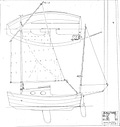
Boat Designs: Evaluating SCAMP’S Big Sister
(this new welsford cruiser checks a lot of boxes…).
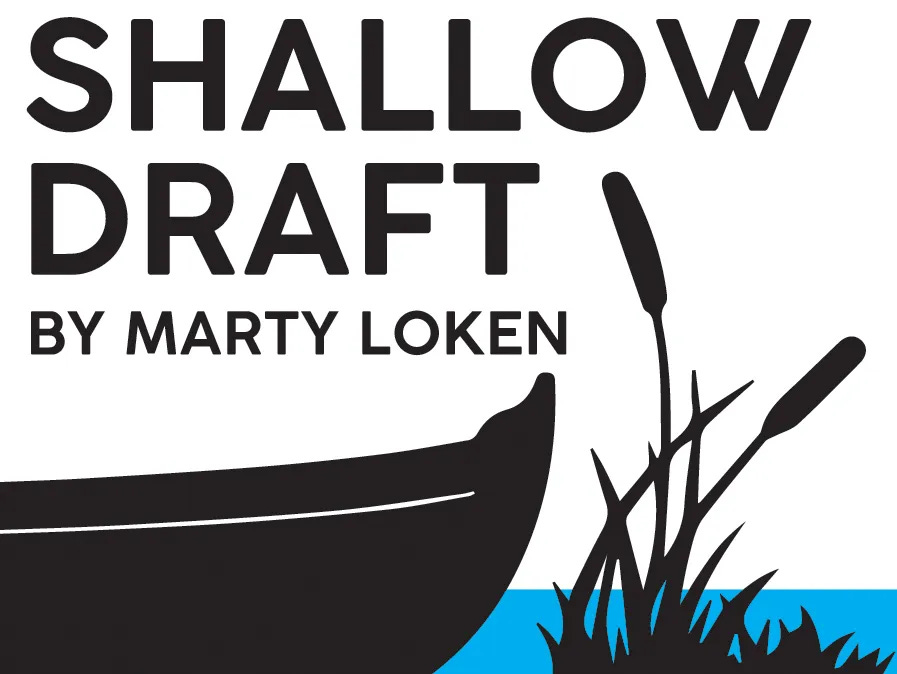
Over the past few days I’ve had email exchanges with John Welsford, New Zealand designer, regarding a brainstorm that’s been percolating in his clever, whimsical noggin: A bigger, more commodious takeoff on his wildly popular SCAMP design.
As most SCA readers know, the 11’ 11” SCAMP design was conceived 13 years ago when Josh Colvin, editor of this fine publication, asked Welsford to come up with a new kind of small cruising boat—one small enough to explore the most hard-to-penetrate backwaters, while being easy to rig, light enough to trailer with the smallest of tow vehicles, surprisingly great under sail, and comfy for overnight camp-cruising adventures. So, following some tweaks by designer and master boatbuilder Kees Prins, the resulting sailboat was dubbed SCAMP, for Small Craft Advisor Magazine Project.
SCAMP DRAWING…
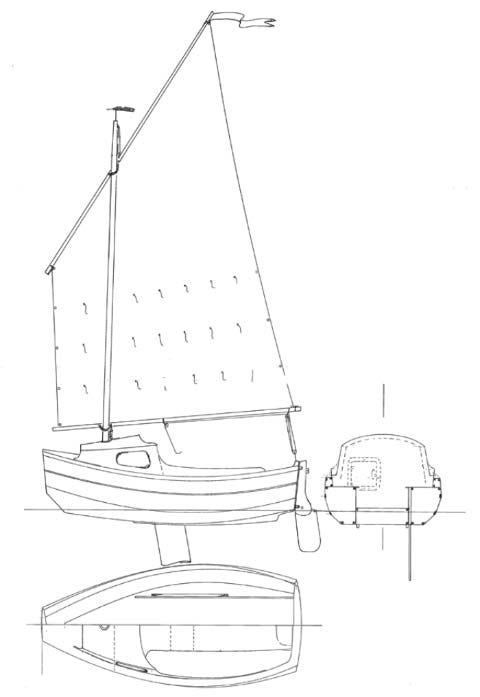
The rest is history: More building plans and kits for SCAMP have been sold over the years than any other small cruising boat we can think of. Besides the original wooden version, Gig Harbor Boat Works was licensed in 2013 to produce a fiberglass SCAMP, and the little giant killer—in wood and fiberglass—has since its debut been at the center of various small-boat rallies, workshops and sailing events.
While SCAMPs are still being built worldwide by enthusiasts, plan and kit sales have slowly been approaching what might be a kind of saturation point. It’s not that “everyone who wants a SCAMP has already built one,” but we get the feeling that it’s time for something new and different—like a SCAMP-inspired design that has the personality and quirky appeal of the original boat, but with more creature comforts (for an aging population of SCAMP lovers).
Meet SCALLYWAG, John Welsford’s big sister to SCAMP, a 15’ 4” x 7’ 3” wonder with a “real” cabin, tabernacle mast, mizzen sail, powerful main, water-ballast tanks, sitting headroom down below…and like SCAMP, faster than many onlookers might expect.
SCALLYWAG DRAWING…

This might turn out to be a timely, common-sense follow-up to the successful SCAMP design—so tempting that John Welsford is talking about building one for himself.
(As a footnote, we might add that in 2008, prior to the introduction of SCAMP in 2010, Welsford came up with another design that was similar to but somewhat larger than SCAMP—called TREAD LIGHTLY, which measured 13’ overall, with a beam of 5’ and addition of a mizzen. The series of similar hulls began with PEANUTS, an experimental build that never quite made the plans list. That design led to TENDER BEHIND, then SHERPA, then TREAD LIGHTLY, then SCAMP, then SCRAPS and now SCALLYWAG. Quite a series!)
TREAD LIGHTLY drawing…immediate predecessor to SCAMP)
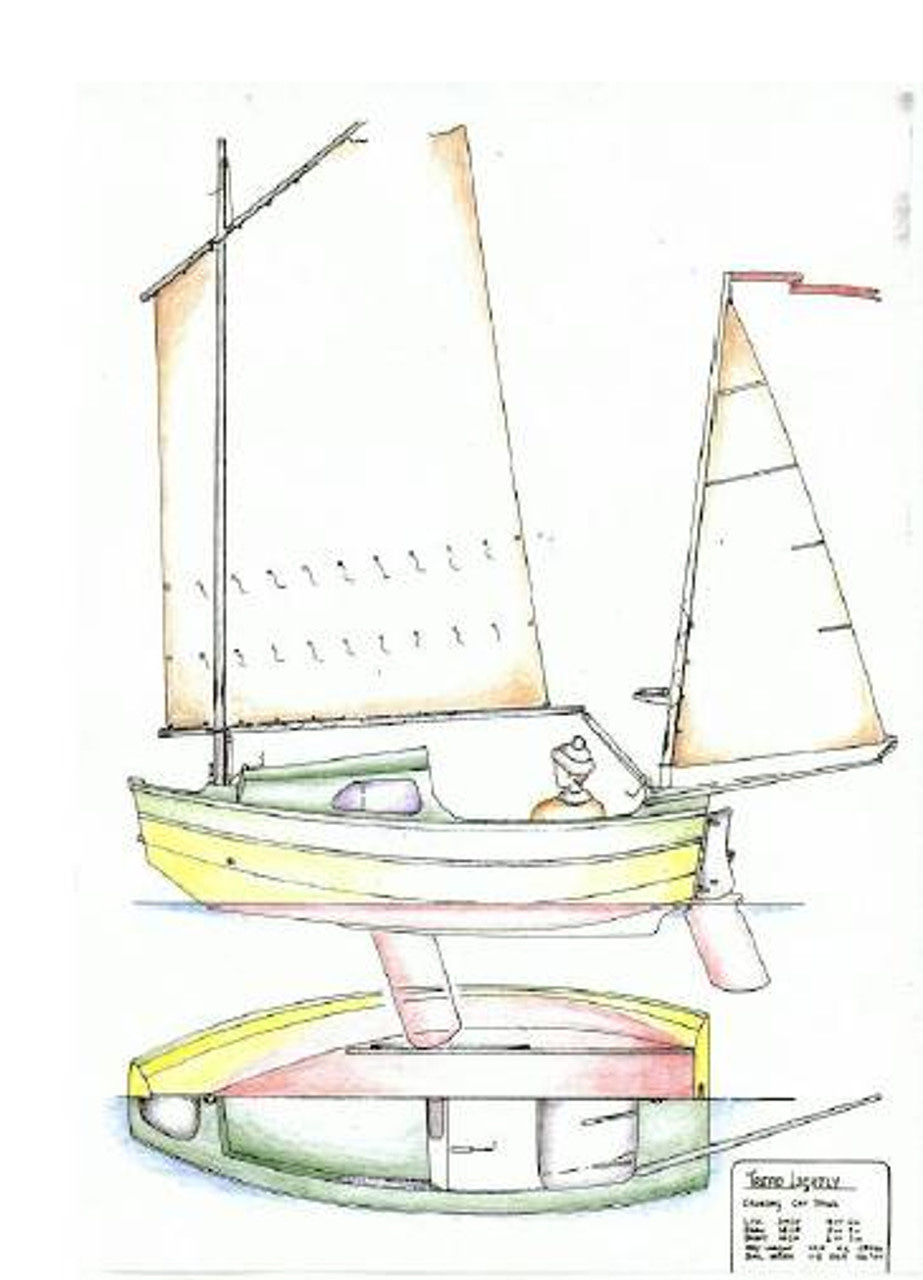
Here is John Welsford’s description of the SCALLYWAG design:
“I’ve had a number of people tell me they love SCAMP, but they’d like a ‘real’ cabin—something that would provide shelter for a couple of friends to overnight out of the rain; somewhere with space enough for four to sit and chat over coffee or rum on a cold evening; somewhere with a bench for a cooker, a table to eat the food off of, and lockers for all the essentials…and room for the skipper and first mate to stretch out and sleep in comfort.
“SCALLYWAG is not so big as to make launching and retrieving a chore; her mainmast is in a tabernacle, which makes standing it up easy-peasy for clients who don’t like the idea of lifting a mast that size vertically into place. Her mizzen is light enough to not be a worry, too, in that respect.
“The rig is a powerful one, but easy to access for reefing, and she will heave to under mizzen with the main let free so she sits mostly head-to-wind, dry and restful if a gust has to be waited out.
“I’ve added a pair of big water tanks for ballast, so with that and her beamy shape she’ll be very stable. Her cockpit self-drains, the motor is inside the tall transom for easy access, and while there’s room in the cockpit for four, she’ll be easy to single-hand and relaxing to sail.
“While the relationship between SCALLYWAG and SCAMP is obvious, it’s not just the styling. The backroom calculations in hydrodynamics suggest she’ll handle well, and be faster than many expect. With high stability and the ability to sit upright when aground, she’ll be able to transition from hiding in the mud or sand up a creek somewhere, to making a longer coastal passage without any fuss.
“Construction is simply plywood over ply bulkheads, with stringers to line everything up, and with considerable buoyancy just in case. The plans will have scale drawings of all major components, and we anticipate soon having printable full-sized templates for frames and other key items.”
As for specifications, beyond the overall length of 15’ 4” and beam of 7’ 3,” SCALLYWAG will have board-up draft of 10,” a board-down draft of 3’ 4,” a total sail area of 143 s.f. and a fully-rigged dry weight of 750 lbs. (Incidentally, the beam-to-length ratios of SCAMP and SCALLYWAG are almost identical.)
John Welsford says that plans for SCALLYWAG will be available on December 1, but he can take orders in the meantime. Price will be $245 U.S. funds for emailed, printable PDFs, and the plans can be ordered via John’s website: jwboatdesigns.co.nz (Joel Bergen, well-known for the Welsford Navigator he built and sails in many Northwest small-boat events, will be developing a set of SCALLYWAG patterns in the not-distant future, according to Welsford. Editor’s note: We heard from Joel yesterday; he’s hoping to develop CAD-produced patterns “in a few weeks,” now that he’s received initial SCALLYWAG drawings. Stay tuned; we’ll provide updates on plans and patterns in this space.)
FIRST IMPRESSIONS OF THE SCALLYWAG DESIGN:
Eager to hear what SCAMP-savvy friends might have to say about the SCALLYWAG specs and just-released drawing, we sought initial reactions from…
JOSH COLVIN, editor of Small Craft Advisor , who commissioned the SCAMP design in 2010 and enjoys sailing SCAMP #1:
“There’s certainly no doubt who designed this one! It looks almost as much like Welsford’s PENGUIN as a SCAMP. SCALLYWAG’s length is a sweet spot in terms of accommodations potential. She’ll be rowed less than most SCAMPs, but I love the inboard motor well to keep her lines clean, and the engine right at hand. But her most exciting feature is the addition of the mizzen, which will improve seaworthiness and make managing the mainsail easier.
“Between LONG STEPS and SCALLYWAG, those looking for something like SCAMP, but larger, have great options. I’m excited to see the first boat built—she will be bigger than most expect, just looking at the drawing.” SIMEON BALDWIN, builder of an early SCAMP who has perhaps sailed more nautical miles with a SCAMP than anyone…and who has also served as a generous advisor to fellow SCAMP builders and is an expert on rigging and sailing the little 11’ 11” boats:
“I like what I see of this long-rumored design. Knowing John and his attention to ergonomics, I can anticipate it will work well. The tabernacled mast and addition of a mizzen are most appealing.
“From the drawing I think it may resemble LONG STEPS in terms of the recessed footwell. It also appears he is eschewing a by-design lazarette made popular by many SCAMP owners.
“The double water tanks are something to contemplate. I don’t envision SCALLYWAG as a purpose-built racer with crew, actively keeping high-side ballast on long tacks, like the SKATE 15 that Brandon Davis designed, which utilizes two tanks and a dump-valve system that may be more elaborate than a typical cruising sailor would want to live with. But John may be describing two water tanks that are filled and remain separate from one another.”
(Editor’s note: Welsford’s comment on tanks, “The ballast tanks are linked, and they’re not far enough off the centerline to work independently. There is one each side of the aft end of the centerboard case and they go out as far as the seat-front extensions.”)
“I’m looking forward to how all of this works out!”
BRANDON DAVIS, of Turn Point Design in Port Townsend, whose company cuts CNC kits for the SCAMP and a variety of other small boats. Brandon is also a skilled designer and small-boat sailor:
“I really like this boat, since it has just enough room to have a cabin but it’s still small enough to be trailered, beached and easily built in a garage. The enclosed cabin should encourage longer trips or taking a friend along.
“The longer waterline should increase average sailing speeds. My guess is that rowing speed will be lower than the SCAMP, as the rower will not be able to take advantage of the waterline length because of her weight.
“Will SCALLYWAG be offered as a kit? I could see it selling well as a kit and the market could be ripe. Many SCAMP builders might consider this as their next build.
“I look forward to seeing the first SCALLYWAGs on the water!”
KEES PRINS, designer and boatbuilder, who constructed the first SCAMP while serving as boatshop manager at the Northwest Maritime Center…and in the process suggested and implemented some changes that improved the design:
“I think SCALLYWAG will find a great following in the SCAMP world and beyond. Adding a cabin will greatly enlarge the ‘SCAMP Crowd.’ At that beam, and with twin ballast tanks, stability should be enormous for a boat this length. I would have liked to see a cross section through the cabin to know more about sitting comfort. (Four people hanging out inside seems a little optimistic, but two should be comfortable.)
“I’m curious about what the tabernacle for the unsupported mast will look like. A big sail area, together with a stiff hull will induce a significant load on the tabernacle. There seems to be a deep well for the mast base to swing through, judging by the drain hole.
“All in all, SCALLYWAG looks very promising.”
OSCAR LIND, a serious student of all various small-boat designs , and earlier builder of a SCAMP, who shares at least one thing in common with John Welsford—they’ve never met a pun they didn’t like:
“I might have to clear out the shop and make as much room as possible to build this boat (due to the 7’ 3” beam, especially). It’s so tempting and fills the bill for usability and function.
“It does need a Chinese lug rig, though. I expect quite a few SCALLYWAGS will ultimately be built.”
(Editor’s note: John Welsford comments, “I like the Chinese lugsail, but for a sail of this size on a boat that will be trailered, rigged and derigged for each outing and dry-stored, the extra complexity of the Junk sail slows the process. As well, the balanced lug is in my experience, a little quicker upwind—unless the junk rig has cambered-panel sails, and there are few sailmakers producing those, so I think in this case, simplicity and performance get the nod.”)
As for my personal view as a serial boatbuilder, restorer and sometimes buyer of project boats, I enjoyed owning a SCAMP several years ago. While I loved sailing the boat, I wished it was bigger and included a sleeping cabin. So, John’s new SCALLYWAG design checks many more boxes as an all-around keeper, and I prefer its overall hull, cabin and rig design, not to mention its potential as a serious cruising machine.
So, once again, here’s a chance for you, as a fellow boat nut, to offer your evaluation of SCAMP and her newly-hatched big sister, SCALLYWAG. (Also, please add other thoughts in the comments section below…) • SCA •
Ready for more?
Boat Profile
A little camp cruiser for big dreams
From Issue Small Boats Annual 2016 October 2015
N ever mind that until grounding on a mudflat less than 30 miles from the finish line, SCAMP #4 breezed through a difficult year in the 300-mile Everglades Challenge adventure race a few years ago, pressing on comfortably when many bigger boats had to quit. Never mind that during the inaugural Race to Alaska earlier this year, SCAMP #11 completed a very rough 40-mile open-water crossing of the Strait of Juan de Fuca, taking its solo skipper safely from Port Townsend, Washington, to Victoria, British Columbia. And never mind that yet another SCAMP (extensively modified for the venture by its builder) may attempt to round Cape Horn—yes, that Cape Horn—this year and, if successful, will be the smallest sailboat ever to do so. Despite all that, the overwhelming impression I get when Dave Ender drives up with his newly built SCAMP to take me sailing is: What a cute little boat.
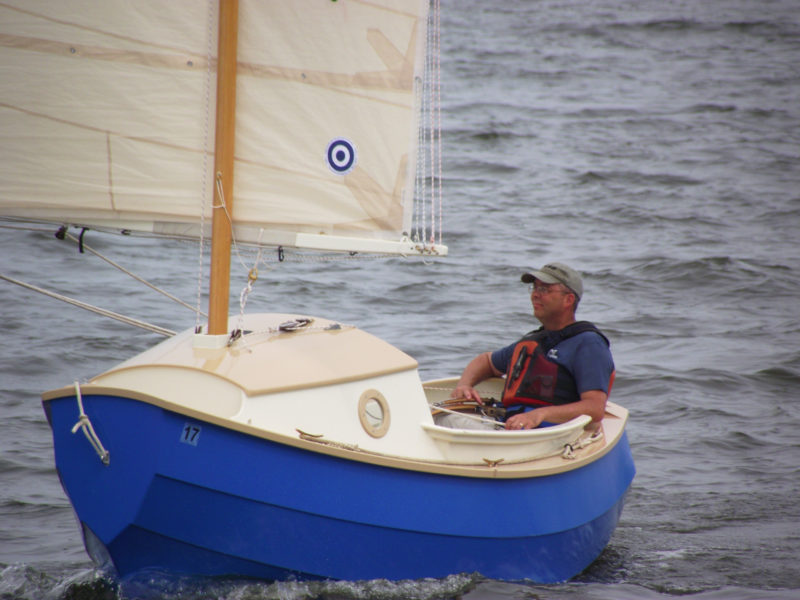
The buoyancy of the blunt pram bow resists digging in while running downwind and reduces the likelihood of broaching.
SCAMP is short, curvy, beamy, and high-sided, with a well-rockered flat bottom and a distinctive pram bow—a cross between a bulldog, a basketball, and an angry rubber duck. It’s also one of the easiest-launching boats I’ve ever encountered. I barely had time to grab my gear before Ender had the boat rigged and ready: mast stepped, sail hoisted, and rudder hung on the transom. He backed the trailer into the water and shoved SCAMP off. Less than 10 minutes from arrival and it was time to sail.
Josh Colvin, who commissioned SCAMP—an acronym for Small Craft Advisor Magazine Project—wasn’t looking for an ultimate adventure boat when he approached New Zealand designer John Welsford (see WB No. 225 for a profile on Welsford and his design work). “My initial goals for the boat were based largely on a 150-mile sail down the Columbia River, from Beacon Rock to Astoria,” Colvin says. “I kept coming across backwaters and shallow estuarine areas and thinking, That’s where I really want to go , but my 16-footer was too deep, wasn’t easy to row, and if I wanted to overnight up among the reeds, wouldn’t dry out level if the tide left. So the idea I eventually took to John Welsford was for the smallest possible boat that would be able to do all of these things, but still be seaworthy enough to cope with something like the middle of the Columbia River on a breezy afternoon.”
Judging by SCAMP’s popularity among amateur builders—roughly 340 kits or plan sets have been sold since 2011, with about 60 boats launched—plenty of other people are interested, too. Designer John Welsford sees SCAMP as a sort of 21st-century version of a much-loved classic, the Mirror dinghy. “While we don’t expect to do anywhere near as many boats,” Welsford says, “it’s hitting a similar, but older market.” Along the way, SCAMP has fostered an enthusiastic and supportive community of builders and owners, encouraging new builders to take the plunge.
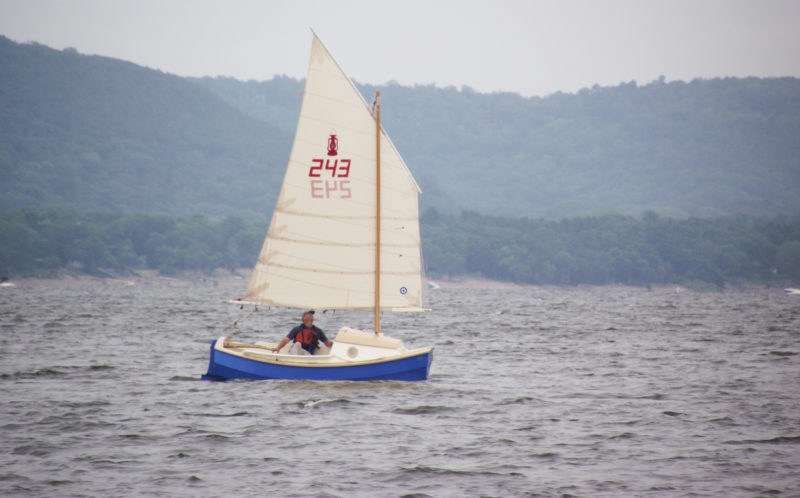
The SCAMPS’s 100-sq-ft sail is set high for good visibility under the boom and is easily reefed.
To bring the new design to life, Welsford was able to make good use of his previous experimentation with similar boats. “SCAMP is number six in a series of very beamy, shallow-bodied boats with that distinctive high-positioned pram bow,” Welsford says. “Tender Behind, Tread Lightly, and Sherpa are the other designs that made it to plans. All work really well, can carry huge loads for their size, sail well, and are well balanced. I learned something from each of them, and SCAMP is a result of that learning.” Besides Welsford, boatbuilder/designer Kees Prins of Port Townsend, Brandon Davis of Turnpoint Design , and adventurer/prototype tester Howard Rice all contributed to final design details and kit elements for SCAMP.
SCAMP is built upright on its flat bottom, which serves as the base for an egg-crate arrangement of plywood that forms the boat’s furniture and structural members. No temporary molds or frames are used. It’s a method that makes for an exceptionally stiff hull, and a safe one—the completed “boxes” create six entirely separate buoyancy chambers within the glued-plywood lapstrake hull. Welsford reports that one SCAMP was able to remain comfortably afloat despite suffering “a hole in the side that you could put your head through” after hitting a snag. And although there are plenty of parts to assemble when building a SCAMP, no single step requires more than moderate woodworking skills and a selection of basic tools.
S CAMP is rigged with a single balanced lugsail, an excellent choice for a cruising rig that’s simple to handle and easy to reef. With 100 sq ft of sail and the stability to stand up to it, the boat also performs well. On my second sail in a SCAMP, working to windward on a gusty day, I was able to keep ahead of a 21′ Sea Pearl for several miles. SCAMP’s shallow draft and flat bottom make it a perfect gunkholer, and 173 lbs of water ballast (roughly 40 percent of the total hull weight) make it capable of much more. It’s no pulling boat, but SCAMP won’t be too difficult to move under oars when necessary. Some builders have considered experimenting with a single sculling oar at the transom; Dave Ender plans to try a yuloh. There’s room to mount a small outboard on the transom for backup propulsion.
Builders have the choice of building from plans or from a kit, with custom sails and hardware available for purchase. Another popular option for builders is the SCAMP Camp , a two-week intensive class in which participants come together to assemble their own SCAMP kits under the direction of designer John Welsford and prototype tester Howard Rice.
One unintended feature of the design deserves mention: several SCAMP builders I have met describe the boat as “a chick magnet,” and from my own observations at various messabouts and festivals, I’d say that such a claim is closer to reality than to hype. For potential builders with wives or girlfriends reluctant to take up sailing, this might be the single biggest advantage SCAMP has to offer.
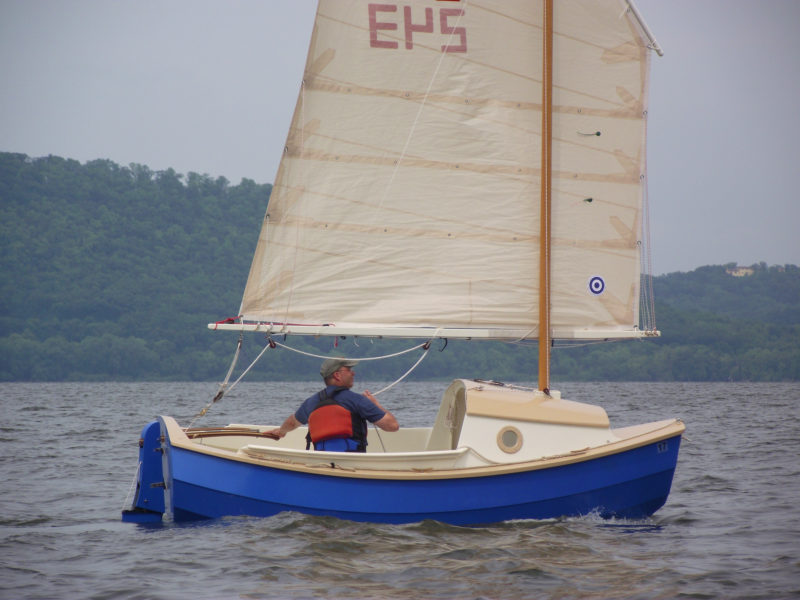
A kick-up rudder allows sailing in shallow water and twin skegs help the SCAMP sit solidly upright when grounded.
B ack aboard Dave Ender’s Scamp, we were away from the dock with an easy shove, heading across Lake Pepin, a wide stretch of the Mississippi that’s often subject to strong winds sweeping down between tall bluffs. Dave filled the ballast tank under the cockpit sole. With the drain holes open, the tank floods itself almost completely; the top of the tank is a few inches above the waterline, so must be topped off by replacing the plugs and pouring water in with a bucket from the cockpit before sealing. He could pour water in quickly without worrying about spilling or overflowing: The excess water drains out of the cockpit’s scuppers. With the water ballast in, we soon shook out the reef we started with, and Dave put me at the tiller. It was a windy day, but even under full sail we continued on in perfect comfort. SCAMP may be a small boat, but it’s the biggest small boat I’ve ever sailed. In fact, it’s almost impossible to categorize SCAMP by size. It weighs just over 400 lbs empty, but has the cockpit and freeboard of a 20′ keelboat (in fact, the freeboard is so high that reboarding the boat without a pre-rigged foot stirrup or rudder step would be problematic). It’s easy to drag up a SCAMP onto a beach for a quick stop ashore, yet filling the ballast tank adds stability well beyond the reach of a typical small boat. The self-draining cockpit sits high enough above the water that you feel like you’re aboard a much bigger boat—yet SCAMP is extremely maneuverable, tacking easily and spinning around within its own length like the smallest dinghy.
While it performs well enough to keep experienced sailors interested—Dave and I kept pace with several much bigger keelboats without much trouble—SCAMP would also be a great boat for beginners to learn on. The balanced lug makes tacking or jibing very simple and stress-free; lazyjacks hold the sail and boom securely in place, making reefing easy once the lines and cleats are set up; the boat is stable and comfortable. And it’s pure fun to sail. The only thing that I needed some time to get used to was being so far from the water compared to the sail-and-oar boats I usually sail. Of course, that higher freeboard and greater volume help make it easy to recover from a capsize (see the video below). By the time Dave and I returned to the dock, I was reminded again of just how much I like this design, and how much it can do.
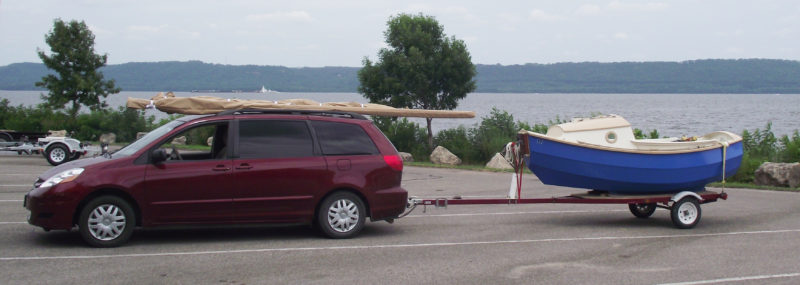
The diminutive SCAMP is easily trailered, rigged, and launched.
With its quick launching capabilities, SCAMP would work well as a family-friendly daysailer. There is space enough for four adults in relative comfort (three is better; two is luxurious), and the boat’s stability makes it a comfortable ride even for the elderly and infirm, young children, or passengers who might simply be a bit nervous around boats. The boom is high overhead, minimizing the risk of hitting an inexperienced passenger, and the seats are wide and comfortable.
Cruising solo or two-up is where SCAMP really shines. The 8′3″ x 29″ cockpit sole provides ample space for one person to sleep aboard very comfortably (the offset centerboard is hidden in the starboard seat face), and filler planks between seats can be used to create a double bunk. The benches themselves (6′8″ by 17.5″) offer a place to stretch out but aren’t quite wide enough for sleeping. There is plenty of stowage space under the seats and cockpit. The “veranda” (a small cuddy/locker at the forward end of the cockpit) provides additional stowage, sitting headroom, and shelter from the wind, as well as a convenient place to anchor the forward edge of a cockpit tent. Forward of the veranda’s bulkhead there are 8.5 cubic feet of sealed stowage that provide extra buoyancy well above the waterline, just where it would be most useful in a knockdown. And of course, like all small boats, a SCAMP can easily travel to windward at 60 mph, pulled on a small lightweight trailer by a small four-cylinder car.
Tom Pamperin ( www.tompamperin.com ) is a frequent contributor to Small Boats Monthly and WoodenBoat.
SCAMP Particulars
LOA/11′11″ Beam/5′4″
Draft (board up)/7″ Weight (including rig)/420 lbs Water ballast/173 lbs
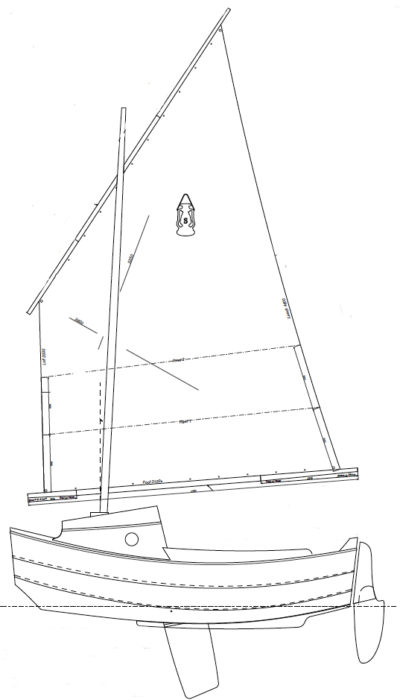
Plans and information are available from Small Craft Advisor . Their YouTube channel has several videos featuring the SCAMP, including a capsize trial with Howard Rice, below.
Is there a boat you’d like to know more about? Have you built one that you think other Small Boats Monthly readers would enjoy? Please email us!
Share this article
Join The Conversation
We welcome your comments about this article. If you’d like to include a photo or a video with your comment, please email the file or link.
Comments (4)
Great article! Thanks. I especially enjoyed the fact that during the capsize test, Howard did not lose his hat! Now that’s a sailor. I’ve always been off put by the punt bow, but seeing the boat in action, I can now appreciate it.
That boat did not want to capsize…
Thanks for the kind words about the article; I enjoyed yet another excuse to go sailing aboard a Scamp. It’s a fun and very very capable little boat, that’s for sure.
These are great wee boats, totally sold on the concept especially the seaworthiness. The only thing I would do differently is wear a safety harness in winds like that in the video! I could quite easily see the boat sailing off while you flounder around in the briny!
Comments are closed.
Stay On Course
More From This Issue
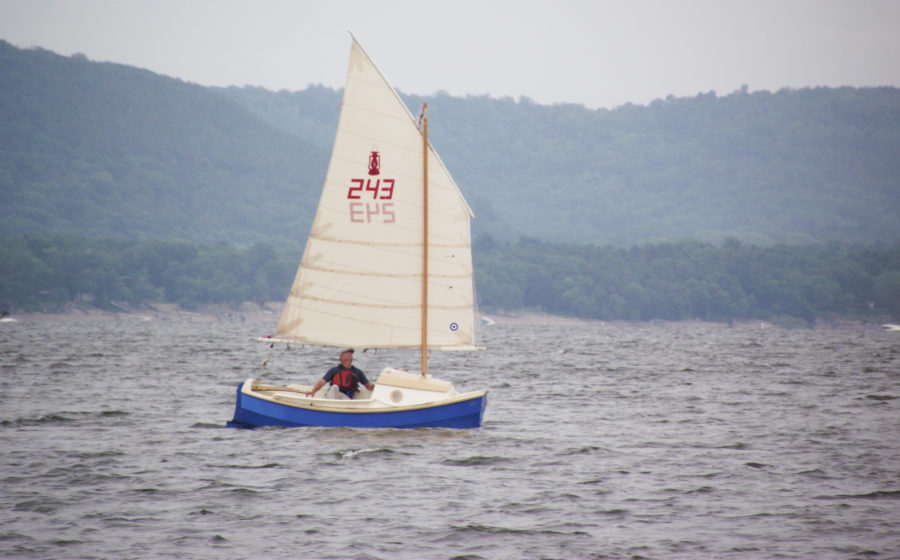
Never mind that until grounding on a mudflat less than 30 miles from the finish line, SCAMP #4 breezed through a difficult year in the 300-mile Everglades Challenge adventure race…
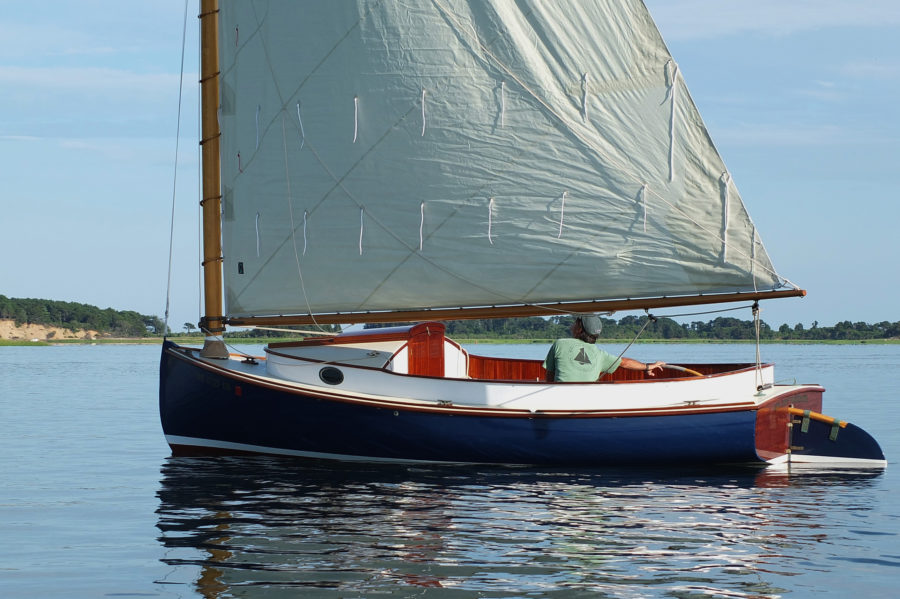
The Caracal
Arey’s Pond is a green, bowl-shaped jewel, one of several ponds in Orleans, Massachusetts, that give access, through narrow, winding waterways, to Little Pleasant Bay and, just to the south,…
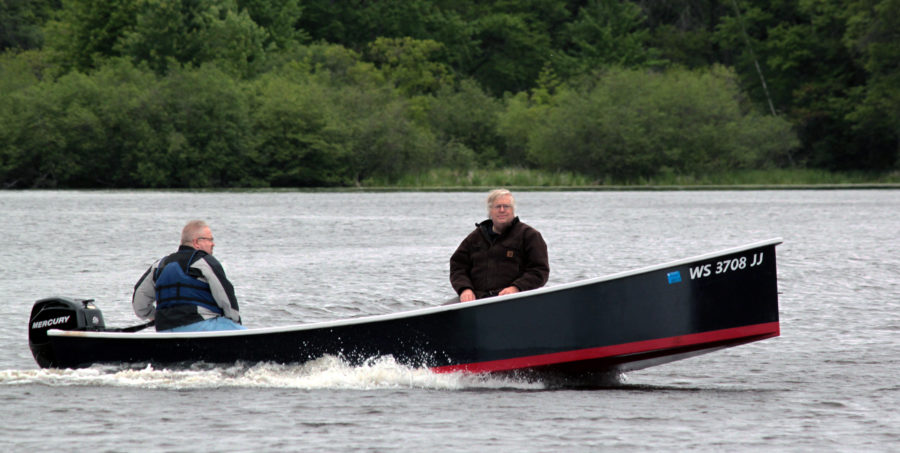
I’ve had a copy of Phil Bolger’s book Boats With An Open Mind for a long time, and I’ve always liked the looks of the Clam Skiff he designed for…
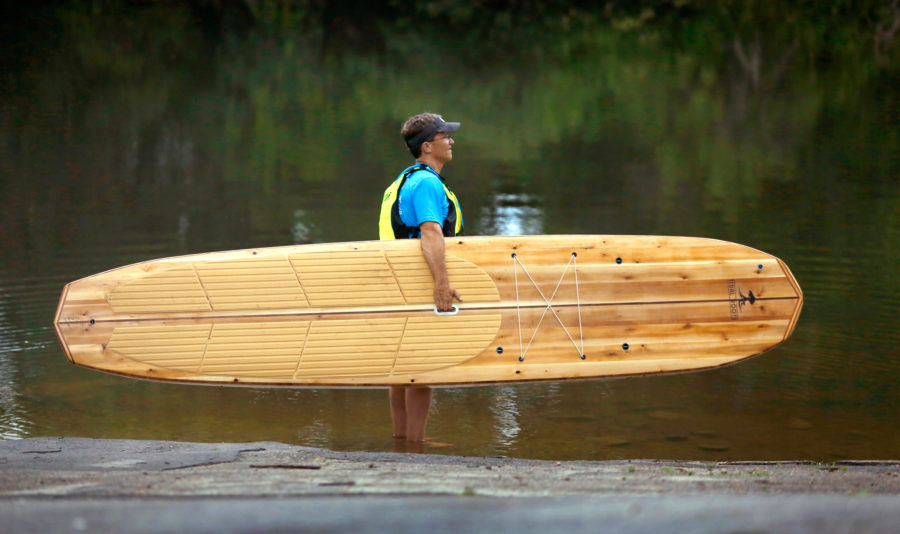
The Sand Bar by Tidal Roots
I was paddling on a placid Royal River with my four-year-old son Noah kneeling in front of me on a wooden Tidal Roots stand-up-paddle (SUP) board. The water hissed quietly…
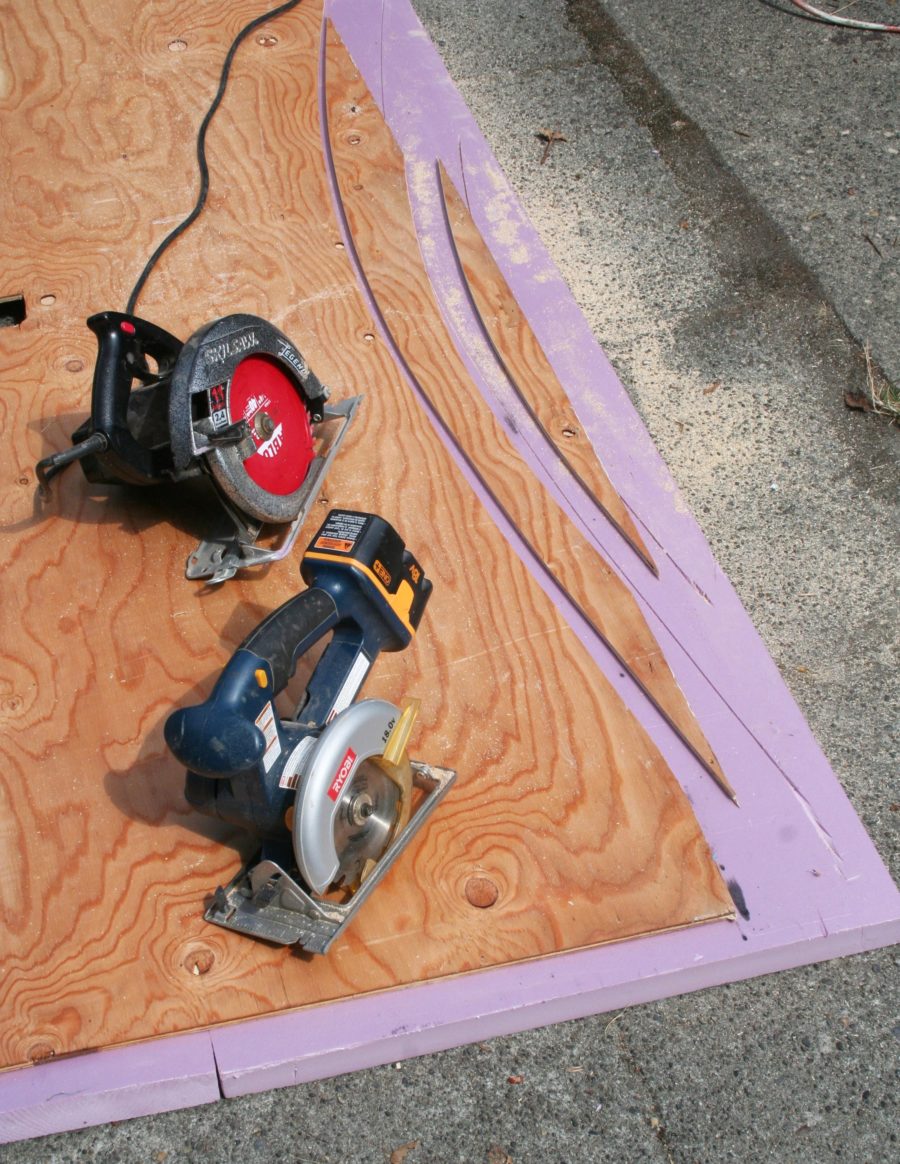
The Taming of the Sheet
Most of us who build boats at home do not have the facilities needed to handle 4′ x 8′ sheets of marine plywood with ease. I’ve always found it challenging…
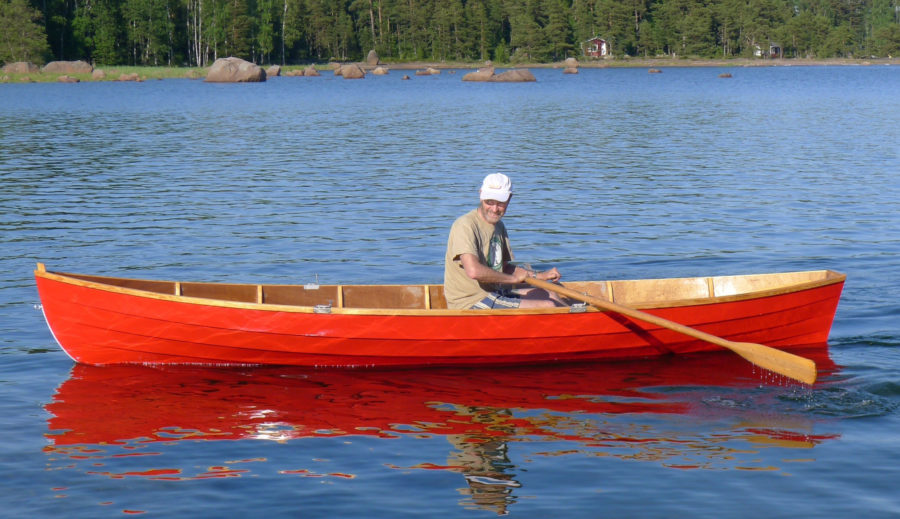
In Finland and much of the eastern Baltic region, networks of interlocking lakes were once the only links between settlements and farms; boats were the only form of transportation. The…
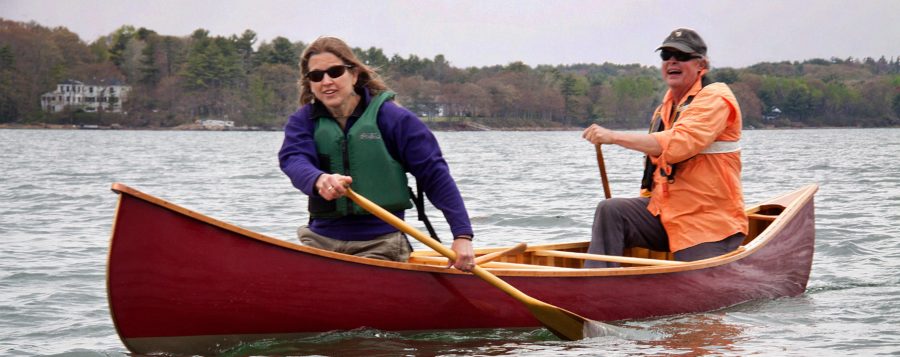
The E.M. White Guide Canoe
Not long after our first wedding anniversary—celebrated with an overnight canoe trip on the Narraguagus River in Maine—Sharon and I acquired our first boat, an 18′ Grumman aluminum canoe, complete…

Made in Vermont
I have always loved wooden boats of all kinds, but especially dories, for their elegant simplicity of design, the way they look upon the water, the way they handle in…
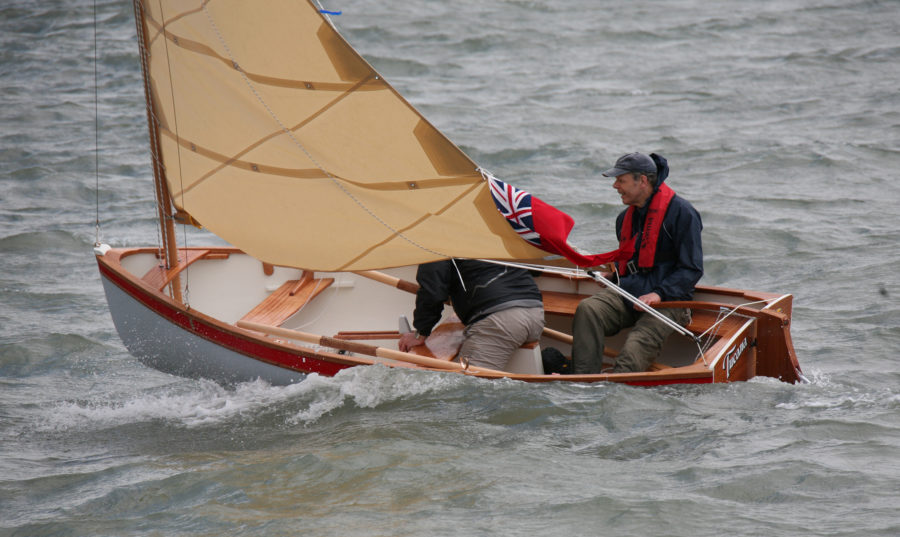
The Mallard
When the now-defunct magazine The Boatman was launched in the early 1990s, one of its objectives was to provide boat plans suitable for amateur construction. One such boat was the…
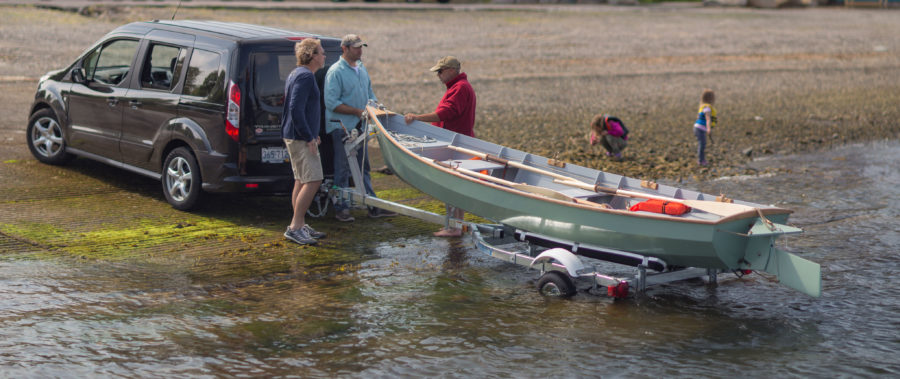
ZO Boats is a new company started by Bill Koffler and Scott O’Connell, partners in Aquidneck Custom Boatbuilding, a company specializing in high-tech composite construction. Involved in modern yacht construction…
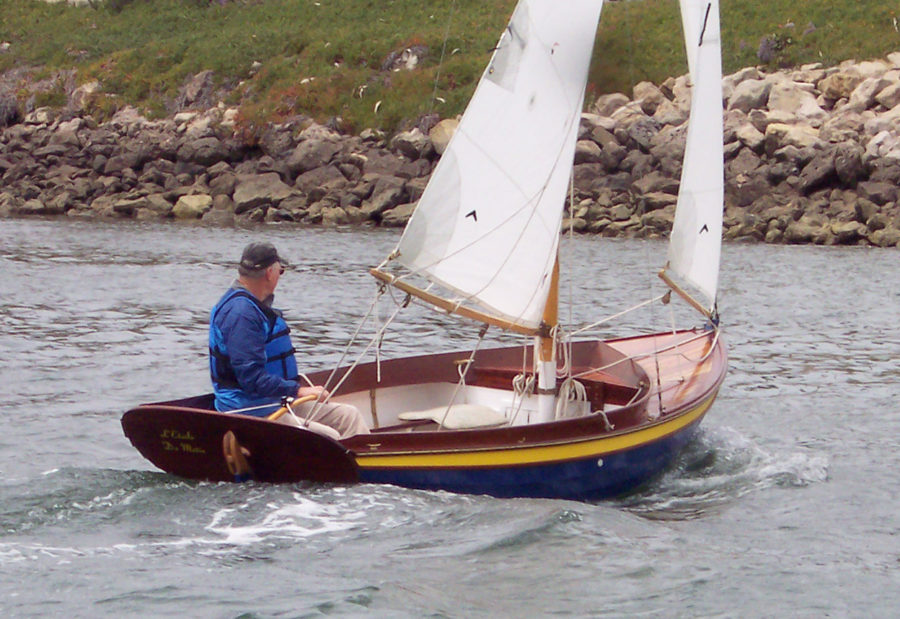
The Somes Sound 12½
A century ago Nathanael Herreshoff designed a 16′ keelboat known widely as the H 12½ after its 12′6″ waterline length. She was intended to handle the steep chop and strong…
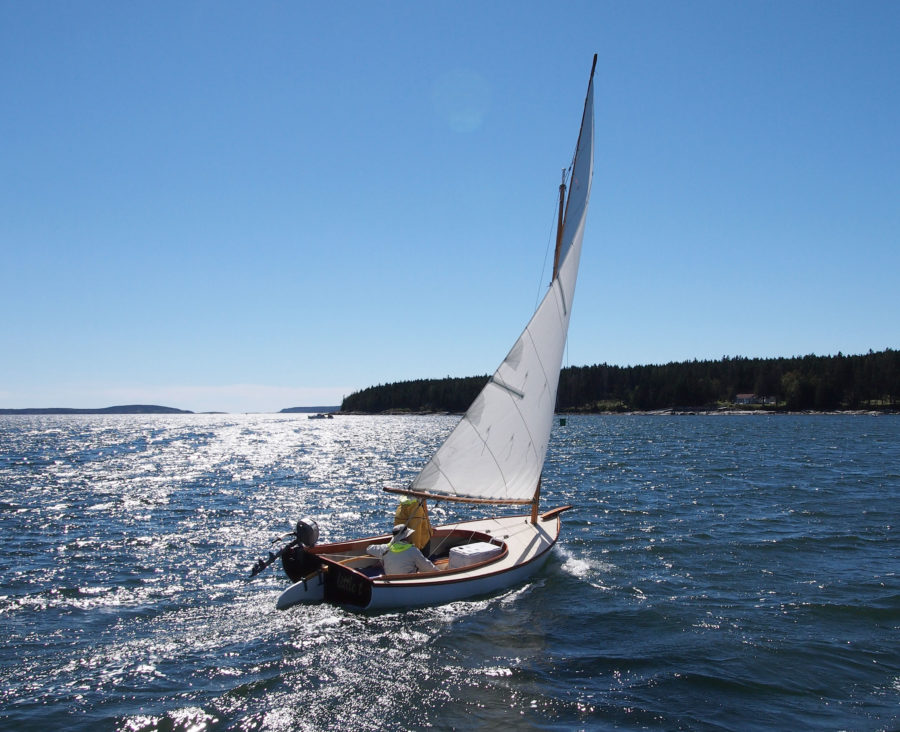
The Marsh Cat
I had spent a long time looking for a boat that I could build to sail the waters of Chesapeake Bay and beyond. The boat would need to be able…
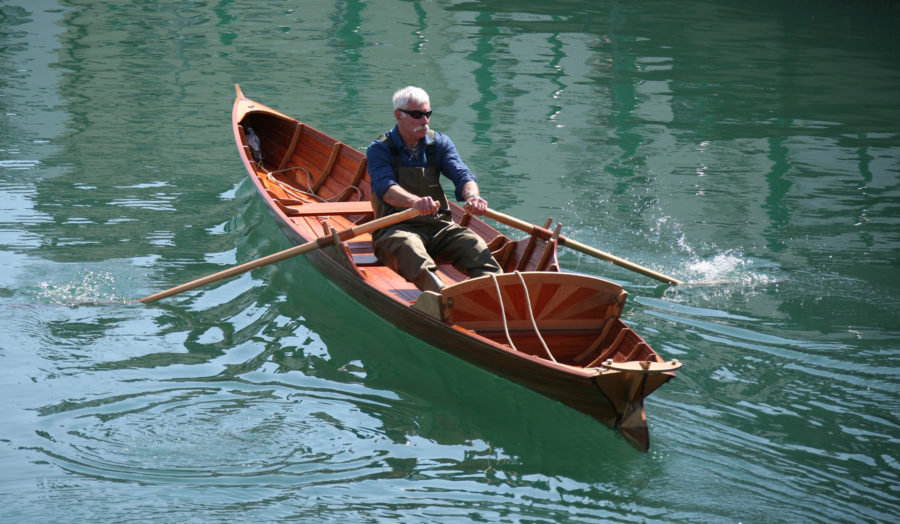
Within the pages of Eric McKee’s Working Boats of Great Britain there are drawings of a 24′ Thames skiff attributed to W.A.B. Hobbs* at Henley-on-Thames in the very early part…
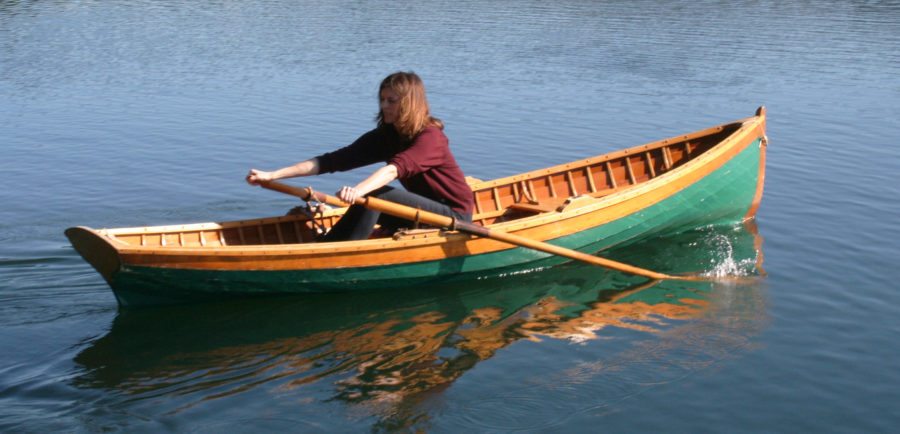
A Lapstrake Livery Boat
What was left of the boat rotting in the brambles on the north shore of Clear Lake in Western Washington was once a very fast boat under oars. Back in…
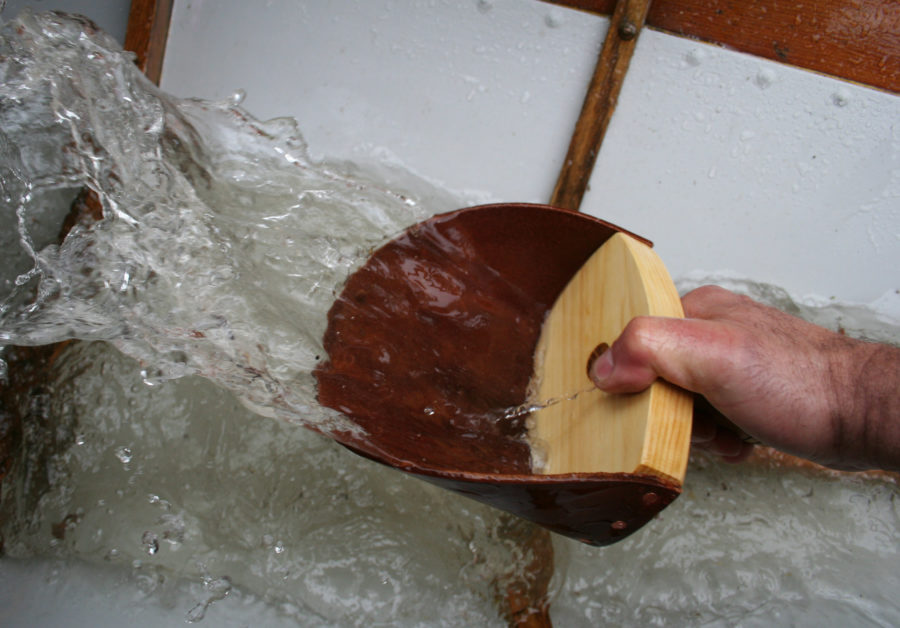
Making a Wood and Leather Scoop Bailer
Once upon a time the boat sharps on the Delaware River were sailing 15 footers with sail areas running to 400 sq ft. No self-bailers, no buoyancy tanks, no crash…
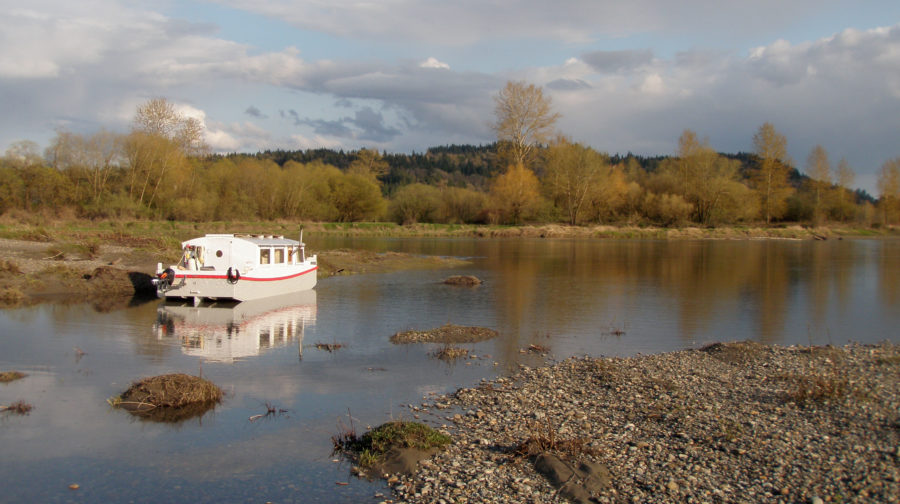
The Escargot canal cruiser
I was sitting in the cabin of the Escargot canal cruiser BONZO, a boat my son, Nate, and his friend Bobby Calnan built the summer after they’d graduated from high…
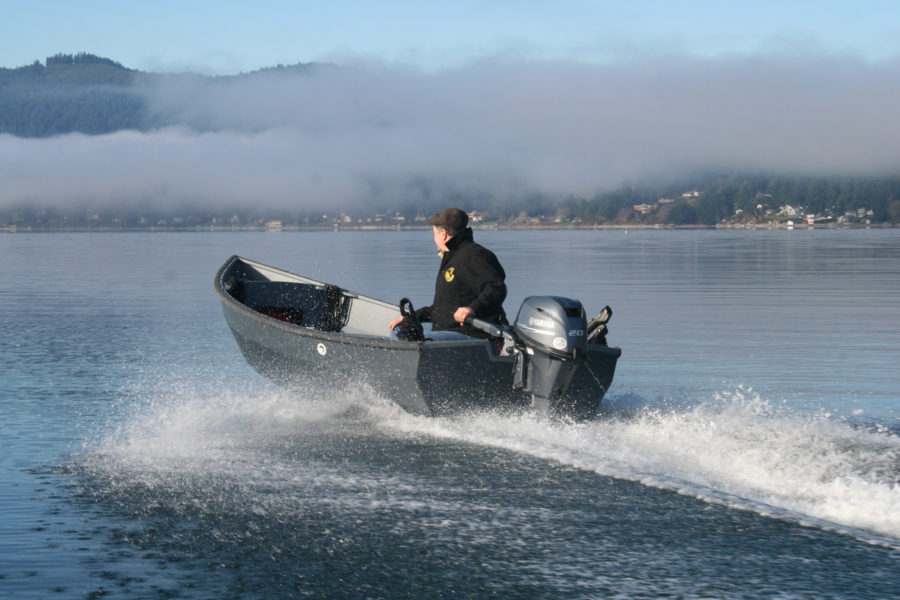
The Candlefish 13
Sam Devlin’s Candlefish 13 began with a client’s detailed request for the design of an outboard skiff suitable for the lakes of Alaska’s Far North. It had to be light…
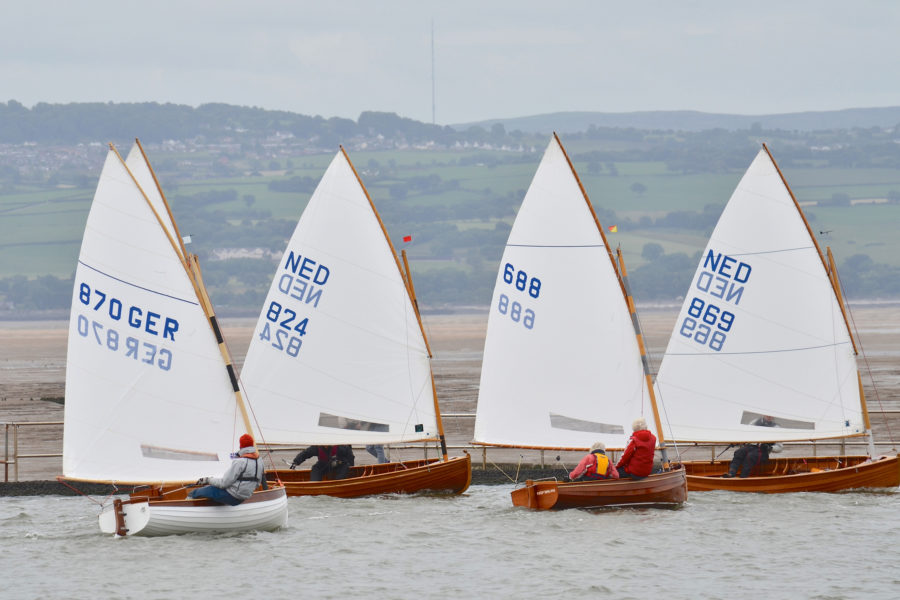
The International 12-Foot Dinghy
In 1913, shortly before the start of WWI, England’s Boat Racing Association (BRA), a small club of sailing enthusiasts, called for a design to comply with the following requirements: length…
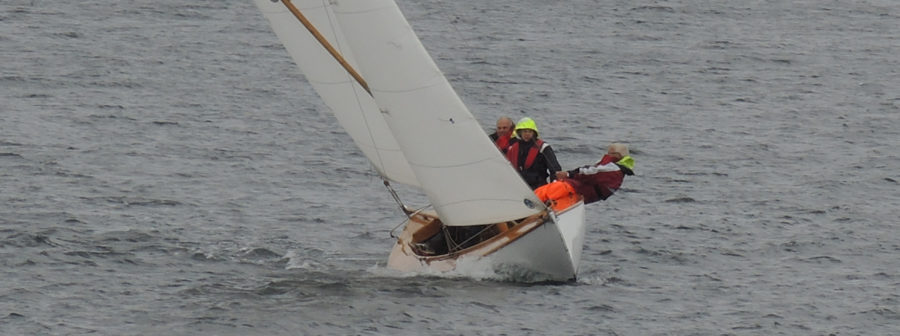
The Færder Snekke
Norway’s Færder snekker constitute a small racing class that hails from outside of Tjøme in the country’s Vestfold region, 55 nautical miles south of Oslo. The two-part name reflects the…
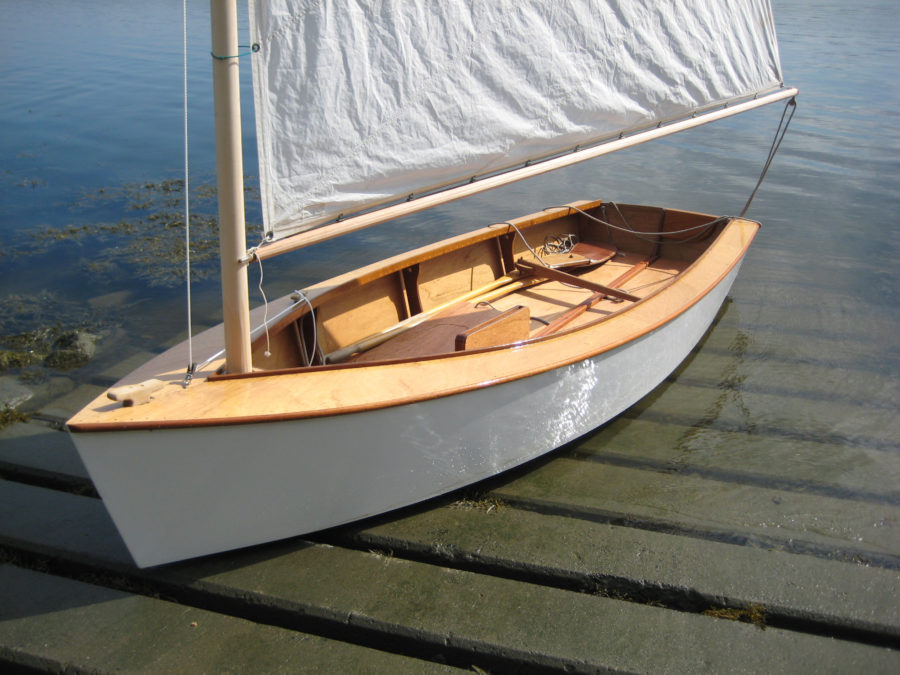
The MerryMac
The MerryMac catboat tends to make the blood hum with a sense of adventure and challenge. Its owners claim that it has always been so since the first of about…
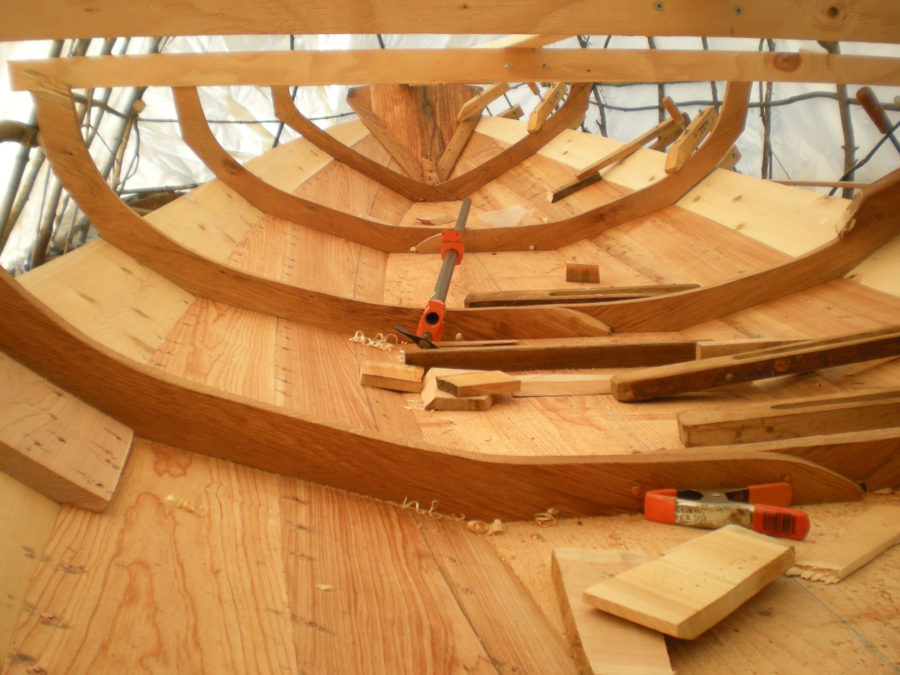
The Mower Dory
One day in the early 1990s, a local contractor visited my boatbuilding shop in Marblehead, Massachusetts, telling me he’d been hired to convert an old boatshop into a playhouse. “The…
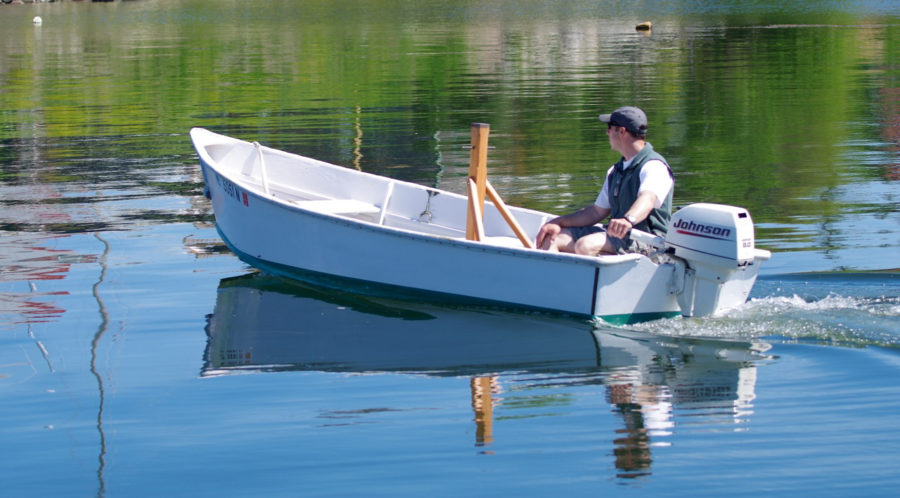
The Willis Boats of Maine’s Dark Harbor
At Dark Harbor, Maine, the legacy of the Rossiter Skiff outshines that of even its most popular fiberglass counterparts. Dark Harbor, located on the mid-coast island of Islesboro, is home…
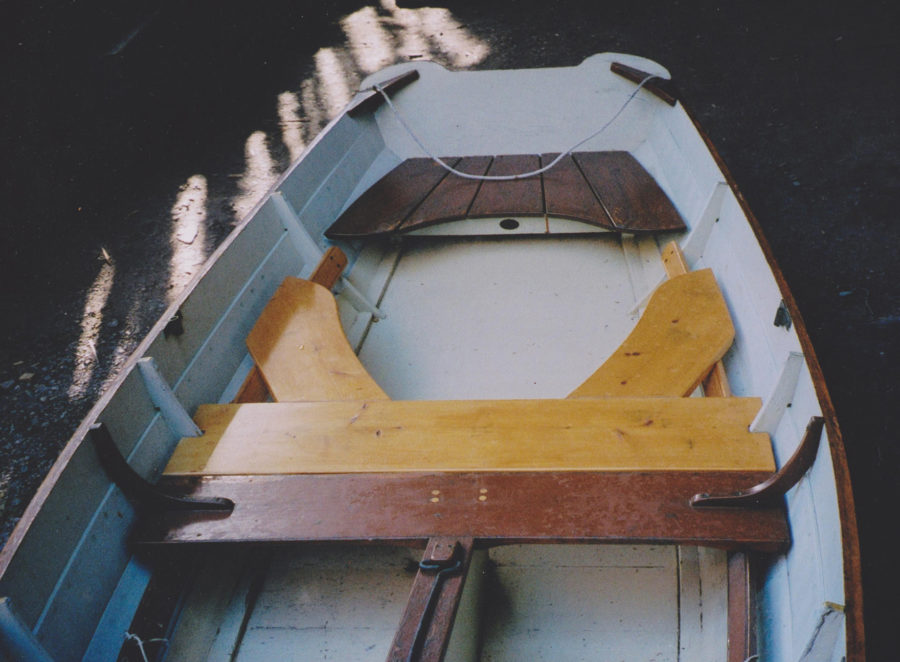
Comfortable Seating for Sailing a Small Rowing-and-Sailing Skiff
As age makes its inevitable changes to the sailor’s once supple joints, certain positions that were once assumed without thought become uncomfortable, if not actually painful. When I was younger…
More Boat Profile
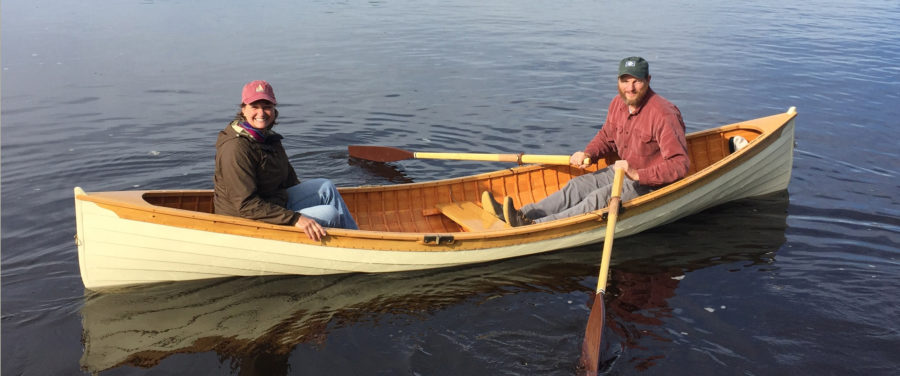
Rushton 109
The Ruston 109 is an old-fashioned guideboat type combining lightness, good looks, and easy rowing. It’s a double-ender with nearly plumb stems, a lapstrake hull, and sweeping sheer. The boat…
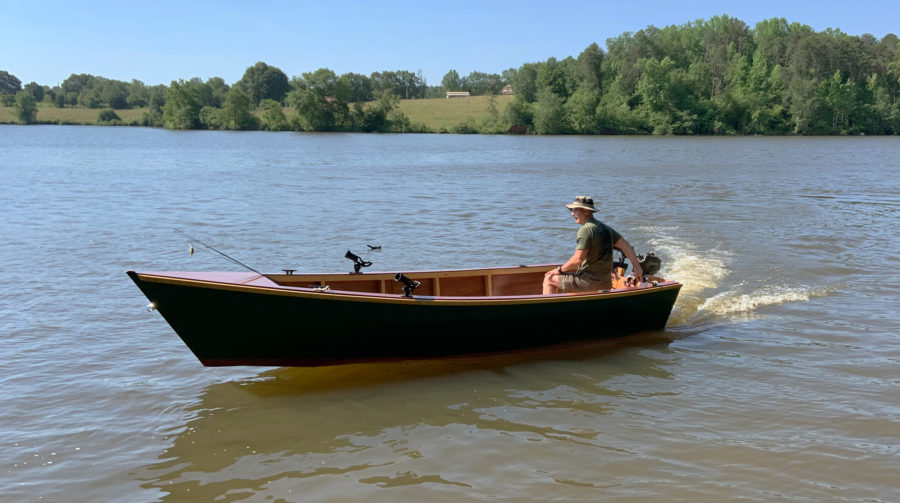
Spira’s Hudson Skiff
I have a full-sized pickup truck, so trailering the lightweight skiff is not at all difficult. Launching at the ramp is similarly not a problem; Hudson floated right off the…
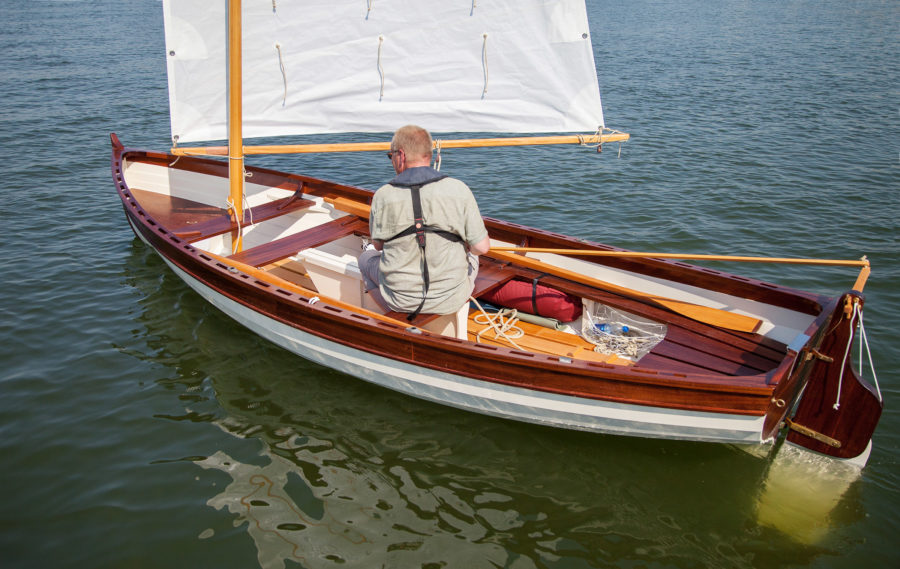
I have been impressed by the solid feel and stability of Penny Fee. Lightly loaded, the transom is well clear of the water, promising good load-carrying capabilities without added drag.…
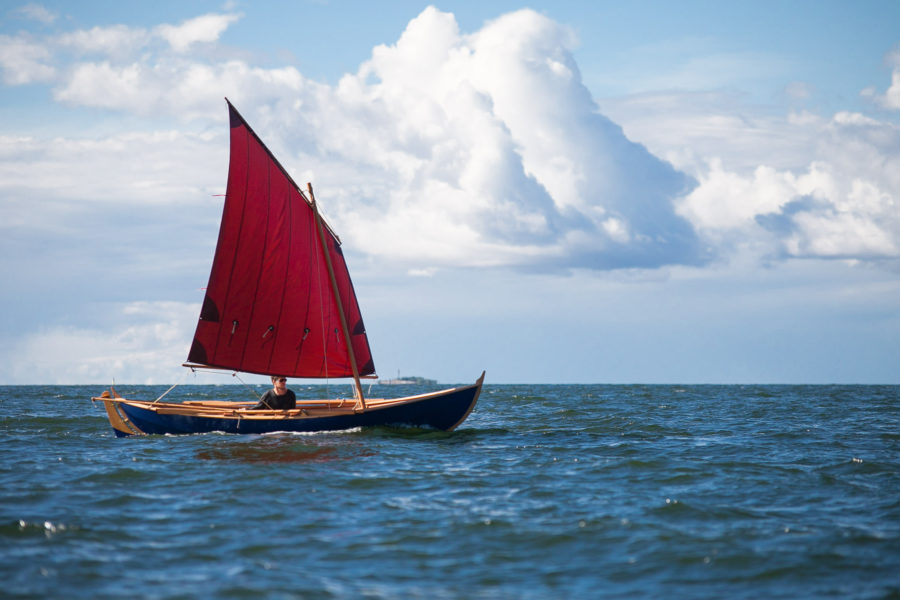
Elfyn sails very well without the daggerboard, even tacking into the wind. When returning to our launch ramp against a light headwind, I raised the daggerboard and Elfyn kept on…
Subscribe Today!
Become a subscriber today and you’ll recieve a new issue every month plus unlimited access to our full archive of backlogged issues.
Already a subscriber? Sign In
Subscribe For Full Access
Flipbooks are available to paid subscribers only. Subscribe now or log in for access.
- Create an Account
- Boat Plans & Kits ::
SCAMP Sailboat

Our own youthful dreams often featured small boats in starring roles. Aboard these simple, stalwart little vessels we'd venture across nebulous bodies of water in search of distant wild shorelines or uncharted islands. We'd land, hike into the interior, and make camp. But always our boats offered refuge from any threat, including summer storms, which we'd wait out beneath our boom tents. At night we'd read sea stories by oil lantern and sleep under a blanket of stars.
Curiously, never once did these visions include negative images of wrestling with a heavy mast and complex rigging, fussing with a smelly, recalcitrant outboard, or being held off shore by our boat's draft. And even when we pictured the afternoon breeze kicking up whitecaps, never once did the vision include a chilly capsize.
It was the dream of returning to those simple pleasures that inspired thoughts of S.C.A.M.P. (Small Craft Advisor Magazine Project). That and a persistent desire to go over "there" - that place we often see but are unable to reach. It seems to happen on every cruise. Never mind that we're usually sailing the smallest boat around for miles, we always come upon some ultra-shallow lagoon or serpentine tidal stream that disappears into the reeds, trees and rushes. To get in there - to really commune with nature - a boat needs to be light, shallow and easily propelled - and preferably flat-bottomed in case we decide to stay right though the ebb. —SCA
Features: Water Ballast Tank • Offset centerboard • Massive Flotation Stowage Cabin • "Veranda" Overhanging Cabintop • Kickup Rudder Flat Bottom and Skegs for Beaching • Voluminous Stowage Lockers 8' 3" Cockpit Sole Single Berth • Convert Cockpit Seats to Double Berth
Original Designer: John Welsford • Design Development: Kees Prins • Kit Adaptation: Turn Point Design
For more SCAMP discussion visit our Scamp Forum here. SCAMP's FaceBook page is here.
You can view the International SCAMP Registry to see where owners are located around the world.

A Boat Called SCAMP by Dick Herman
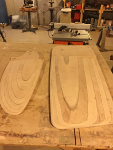
SCAMP Foils Kit

SCAMP Package: Every Article We've Published on SCAMP (issue #63 to #75)

SCAMP Mini Microcruiser Plans
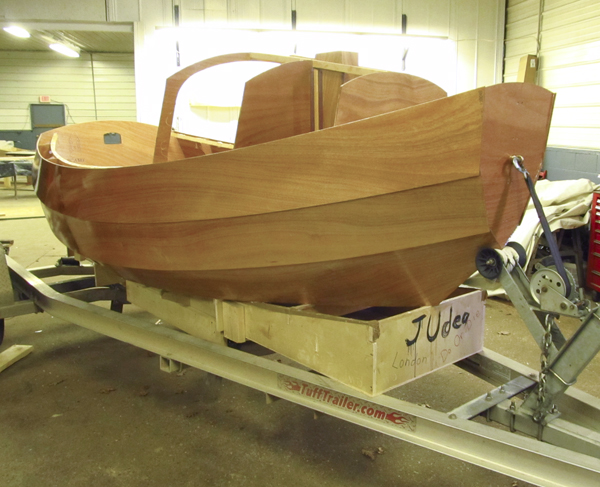
SCAMP CNC Building Kit

SCAMP Class Sail (100 sq ft lugsail)

Official SCAMP Design Logo Burgee
Campy's "WICKED BEAT"
All days should be like today!
Friday, February 1, 2019
Building scamp, an 11 foot long, wood sailboat..
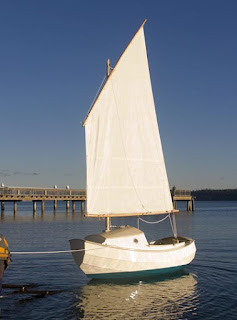
Keep us all up to date with picture's. Sounds like fun...
Post a Comment

Call Us: (253) 851-2126 Mon-Fri 9-5 Pacific Time
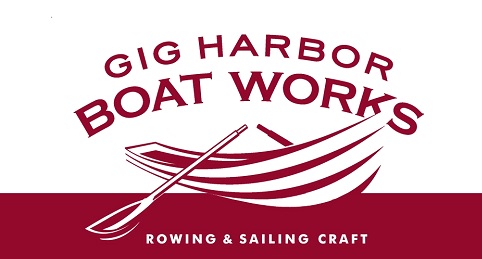
Announcing the SCAMP – in fiberglass by GHBoats!
by GHBoats Webmaster | Aug 10, 2011 | Announcements , SCAMP | 1 comment
The SCAMP is a 12′ micro-cruiser, shown here in wood. We’re now taking the first orders for a fiberglass version!
We have some exciting news to share! We’re adding a completely new boat to our production line – the SCAMP! Those of you familiar with new developments in small craft may have already heard of it… we are thrilled to be able to offer this 12′ micro-cruiser in a fiberglass version, with the same craftsmanship and attention to detail that you’ll find in our other traditionally-styled fiberglass boats.
The new fiberglass SCAMP to be built by Gig Harbor Boat Works will retain all of the characteristics of the wooden versions. Commissioned by Small Craft Advisor magazine, designed by John Welsford of New Zealand, the SCAMP has been available for the past year or so as a plans-only boat. Welford designed SCAMP for wood construction, but SCAMP is much more challenging to build in wood than is first apparent. Multiple bulkheads, reinforcements, water ballast tank, etc. have to be handcrafted in addition to the usual attention paid to frame shape/alignment, plus the usual seam-sealing and finish work. Soon after Small Craft Advisor began to offer plan sets, they received inquiries about when a fiberglass version would be available. The demand became such that SCA came to us and asked if we would be interested in building a fiberglass SCAMP.
We were immediately intrigued at the prospect of adding SCAMP to our line. But as mentioned, SCAMP is difficult to build- particularly so in fiberglass because the tumblehome stern will require a two piece hull mold…. Tooling for SCAMP will require more time and investment than for a typical 20 foot sailboat. And because of that, the retail price of a fiberglass SCAMP will have to be proportionately higher than your average 12’ sailboat.
We also want to ensure that the characteristics of SCAMP in fiberglass will be indistinguishable from well-built wood SCAMPs. Our goal is to have class consistency- in a race, neither wood or FRP construction should have an advantage. Hull shape, ballast tank, displacement and sail rigs must be completely competitive. There will be some minor cosmetic differences applicable to FRP construction, but that will be the limit of changes.
A few key points about SCAMP’s design: SCAMP is an eminently capable micro-cruiser commissioned by Small Craft Advisor magazine, designed by John Welsford. Only 12 feet long, yet the feel of a larger boat. High freeboard, hard chines and full ends give lots of buoyancy and carrying capacity. 178 pounds of water ballast. Flat bottom with keelsons tracks surprisingly well and sits flat on a beach or trailer. Swing keel with kick-up rudder. Balanced Lug Rig with lightweight carbon fiber spars Although only in existence for less than a year, homebuilt versions of SCAMP have completed challenging voyages such as the Everglades Challenge. Proven high capsize resistance and easy recovery. Fast and forgiving nature For further reading about the design, visit http://www.duckworksmagazine.com/10/designs/scamp/index.htm .
Because the tooling and molds will be complex, to help capitalize the project we will make a special ‘pre-introductory pricing’ offer to the owners placing the first six deposits for our fiberglass SCAMP:
GHBW fiberglass SCAMP pre-introductory offer (available to the first 6 buyers) includes: Complete, sailaway SCAMP with custom fitted high quality galvanized trailer for $12,795. Earn cash back; $200 per showing when we send you qualified leads who subsequently place an order. And more cash back; Earn $500 ‘finders fee’ per sale your referrals generate (no lead from us).
A deposit of $6,000 is required to secure this offer and your place in our construction queue. We already have several deposits; once we have the 6 th deposit we will commence tooling and expect to have SCAMP #1 finished about 4-6 months later. All deposits will be placed in a trust account so if 6 deposits are not received in a reasonable time frame they will be refunded 100%.
If this looks like the sort of boat you’ve been dreaming of, give us a call at (253) 851-2126 or email [email protected]! Once this becomes a regular production model, our price will have to go up, so don’t delay!
Click here to see updates about the Scamp development (with photos) on our blog!
Dave, Super news on your involvement in the Scamp. I’ve really liked what I’ve been reading about it in SCA. You and your crew at Gig Harbor Boat Works are definitely the group to pull this off. I know from my experience owning a GHBW Pt. Defiance Skiff, Melonseed and now the perfect Jersey Skiff you guys put togeather for me, that the Scamp will be super. If I were able to do all the expidition rowing I dream about we might be talking about setting one up with my Forward Facing Oar system and you keeping the center board and sails. I’ll be stopping by as the project unfolds for a look see. All the very best.
John Quatermass R/V Mistress Dory Gig Harbor, WA
Newest Posts
- See You at Anacortes Boat & Yacht Show, May 16-18!
- Mailbag: Using a 14′ Whitehall as a Yacht Tender
- Lobster Boat Redesign — Update #2
- Mailbag: Family Diving from a 14′ Whitehall
- New Year, New Digs!
- Beach Dolly (1)
- Best of GHBoats (5)
- Customer Questions (8)
- Customization (1)
- Galleries (4)
- Maintenance and Repairs (3)
- Announcements (13)
- Boat Shows (13)
- Just for Fun (17)
- Mailbag (44)
- Newsletters (25)
- Ocean Rowing (13)
- Press Reviews (10)
- Now Hiring (1)
- Woodwork (3)
- Captain's Gig (2)
- Jersey Skiff (4)
- Lobster Boat (4)
- Melonseed (6)
- Navigator (4)
- Nisqually (2)
- Point Defiance (7)
- Salish Voyager (17)
- Swampscott Dory (1)
- Whitehall (7)
- Sea Stories (12)
- Site Guide (4)
- Uncategorized (1)
Blog Archives
Site search.


BUY MORE SAVE MORE - Now Through Memorial Day! $15 off a $150 order / $40 off a $250 order / $100 off orders of $500+
- Plans & Kits
- Kits and Packages
- Qty in Cart

Scamp Foils Kit

SCAMP CNC PLYWOOD KIT
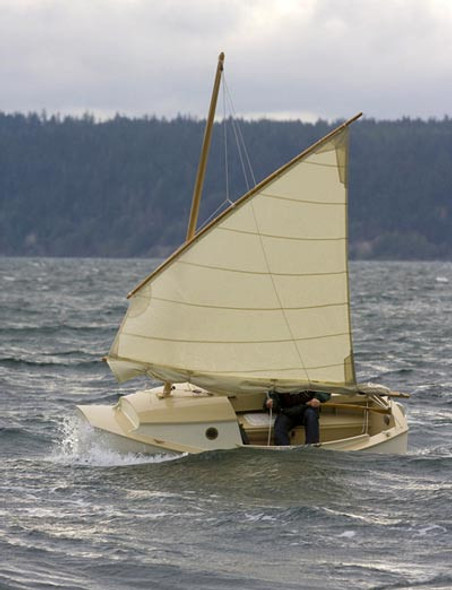
S.C.A.M.P. Plans Instant Download

Scamp Hardware

SCAMP Rigging Kits


Rudder Hardware for Scamp

S.C.A.M.P. Printed Plans

S.C.A.M.P. Sail
- Total: items /
- Add all to cart
Adding your products to cart

- My Boats & Boat Articles

Steps in Building a SCAMP sailboat
Links to all my scamp building pages.
Building a Scamp Saiboat
For me boat-building is a bit of an obsession and as my puddle duck racer was almost finished, i was at the stage of watching the paint dry between coats, i needed a new project., what is a scamp and why is it my next boat building project..
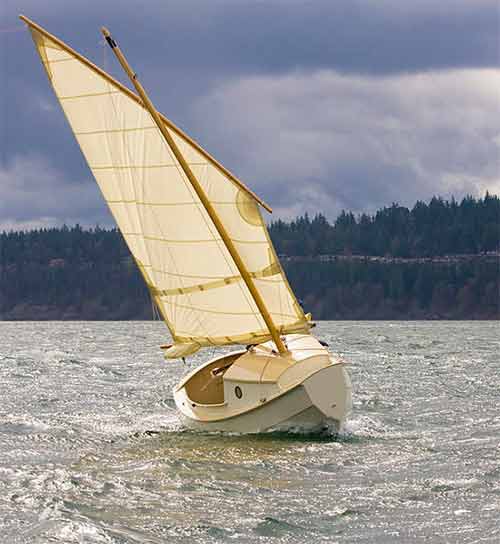
Josh Colvin, editor (and co-founder) of Small Craft Advisor Magazine had ideas about the perfect small craft and asked John Welsford, a successful New Zeland small boat designer, to see if he could design a micro cruiser incorporating the features that Josh Colvin had though up. S.C.A.M.P (Small Craft Advisor Magazine Project) was the result.
What makes Scamp Special? First it's a small boat, an inch short of 12 feet and 5'4" wide. That means it fits easily on a trailer. At about 400 pounds it's not light, but it can be pushed around on a trailer by a couple of people. It can also be launched by one person.
SCAMP has shallow draft, only 7 inches, and because it has double skegs and a flat bottom, it can be beached and will stay level.
SCAMP has an offset centerboard that pivots down. Placing the centreboard to one side means that the large cockpit is uncluttered and because of this it allows someone to sleep on the floor. By putting boards across the (relatively roomy) seats 2 people can bunk down relatively comfortably.
SCAMP has a lot of closed in flotation chambers, 5 in total, (2 more if you close off the 2 back areas) that double up as storage lockers.
Another feature that increases comfort is the Cuddy/Cabin at the front. Part of this gives dry access to the waterproof front storage compartment, and part makes a small porch where a person can sit and get out of the weather or get out of the wind to make lunch.
Below the cockpit sole, centrally located, is a water ballast tank that holds about 170 pounds of water. It is easily filled by opening a watertight bolt. Even with the bolt forgotten open, the boat will not sink because of the buoyancy. To entirely fill the tank you actually have to pour in some water to get the last few inches filled up.
The boat is rigged with a balanced lug which is a docile and effective sail, particularly if it has lazyjacks to control the lowering. Because of the large area of square sails, the mast can be relatively short. This and the fact that the cuddy/veranda helps support the mast, means that it can be unstayed. This results in a simple rig that can be easily handled by one person.
Being easy to single hand is an important feature for me. When I am sailing my Tanzer 22 in increasing wind, it becomes difficult for a somewhat incompetent lady of diminishing faculties to easily handle. I could not want a safer and more reliable craft than the Tanzer but Lake Erie can be sneaky and I worry. My main fear is that the boat will be caught in a side wave when I have left the tiller for a second to deal with something. Lake Erie waves come up really fast and are steep. I sail at the far end and prevailing winds which means a long un-obstructed stretch allow waves to build up.
My lovely Skerry is a perfect dinghy, light, responsive and very safe. She is my boat of choice when the wind is between 4 and 10 knots. She is lots of fun, dry and beautiful. Once the wind goes above 10 knots she is harder to sail because she is so light. Windage makes it difficult to tack because there is not enough mass to carry the boat across the wind. Sand bags or water bottles help but I don't usually have extra weight. The Sprit sail is one of my favourite sail but it is not easy to reef while on the water.
The SCAMP has proved itself to be an exceptionally safe boat even in heavier wind. With lots of buoyancy, extra ballast as water and weight in the centerboard, and an easily reefed sail it provides exceptional safety. One boat was sailed in Tierra Del Fuego.
Even when someone is deliberately trying to tip her over, it is not so easy. Once over she floats high and recovers easily. Because of the high sides, Scamp sailors usually have rigged a stirrup to get back in in case of capsize, otherwise she is tricky to re-enter.

My Team and I have received the plans (kits are available too) and we have been studying the manual. Building a scamp is not impossibly difficult but I don't think it's a beginner's boat either. The building method is a combination of stitch and glue reinforced with wood backing at the seams. There are many bulkheads and interior partitions for the various flotation chambers which provide great rigidity to the boat.
Plywood has also been ordered and received. I got my wood from Oliver Lumber. It's meranti, a bit heavier than the occume that is often used but stronger. This was the cheapest supplier of high grade marine plywood I could find. Not a lot of suppliers in my area. S. Ontario, Canada.
emails: Christine
This web site reflects my personal ideas and doesn't represent anyone else's point of view.
This is the record of how I am building a SCAMP sailboat. I'm building from plans. Because I'm a relatively inexperienced boatbuilder I expect to work slowly and learn a great deal in the processs.

40 Facts About Elektrostal
Written by Lanette Mayes
Modified & Updated: 21 May 2024
Reviewed by Jessica Corbett

Elektrostal is a vibrant city located in the Moscow Oblast region of Russia. With a rich history, stunning architecture, and a thriving community, Elektrostal is a city that has much to offer. Whether you are a history buff, nature enthusiast, or simply curious about different cultures, Elektrostal is sure to captivate you.
This article will provide you with 40 fascinating facts about Elektrostal, giving you a better understanding of why this city is worth exploring. From its origins as an industrial hub to its modern-day charm, we will delve into the various aspects that make Elektrostal a unique and must-visit destination.
So, join us as we uncover the hidden treasures of Elektrostal and discover what makes this city a true gem in the heart of Russia.
Key Takeaways:
- Elektrostal, known as the “Motor City of Russia,” is a vibrant and growing city with a rich industrial history, offering diverse cultural experiences and a strong commitment to environmental sustainability.
- With its convenient location near Moscow, Elektrostal provides a picturesque landscape, vibrant nightlife, and a range of recreational activities, making it an ideal destination for residents and visitors alike.
Known as the “Motor City of Russia.”
Elektrostal, a city located in the Moscow Oblast region of Russia, earned the nickname “Motor City” due to its significant involvement in the automotive industry.
Home to the Elektrostal Metallurgical Plant.
Elektrostal is renowned for its metallurgical plant, which has been producing high-quality steel and alloys since its establishment in 1916.
Boasts a rich industrial heritage.
Elektrostal has a long history of industrial development, contributing to the growth and progress of the region.
Founded in 1916.
The city of Elektrostal was founded in 1916 as a result of the construction of the Elektrostal Metallurgical Plant.
Located approximately 50 kilometers east of Moscow.
Elektrostal is situated in close proximity to the Russian capital, making it easily accessible for both residents and visitors.
Known for its vibrant cultural scene.
Elektrostal is home to several cultural institutions, including museums, theaters, and art galleries that showcase the city’s rich artistic heritage.
A popular destination for nature lovers.
Surrounded by picturesque landscapes and forests, Elektrostal offers ample opportunities for outdoor activities such as hiking, camping, and birdwatching.
Hosts the annual Elektrostal City Day celebrations.
Every year, Elektrostal organizes festive events and activities to celebrate its founding, bringing together residents and visitors in a spirit of unity and joy.
Has a population of approximately 160,000 people.
Elektrostal is home to a diverse and vibrant community of around 160,000 residents, contributing to its dynamic atmosphere.
Boasts excellent education facilities.
The city is known for its well-established educational institutions, providing quality education to students of all ages.
A center for scientific research and innovation.
Elektrostal serves as an important hub for scientific research, particularly in the fields of metallurgy , materials science, and engineering.
Surrounded by picturesque lakes.
The city is blessed with numerous beautiful lakes , offering scenic views and recreational opportunities for locals and visitors alike.
Well-connected transportation system.
Elektrostal benefits from an efficient transportation network, including highways, railways, and public transportation options, ensuring convenient travel within and beyond the city.
Famous for its traditional Russian cuisine.
Food enthusiasts can indulge in authentic Russian dishes at numerous restaurants and cafes scattered throughout Elektrostal.
Home to notable architectural landmarks.
Elektrostal boasts impressive architecture, including the Church of the Transfiguration of the Lord and the Elektrostal Palace of Culture.
Offers a wide range of recreational facilities.
Residents and visitors can enjoy various recreational activities, such as sports complexes, swimming pools, and fitness centers, enhancing the overall quality of life.
Provides a high standard of healthcare.
Elektrostal is equipped with modern medical facilities, ensuring residents have access to quality healthcare services.
Home to the Elektrostal History Museum.
The Elektrostal History Museum showcases the city’s fascinating past through exhibitions and displays.
A hub for sports enthusiasts.
Elektrostal is passionate about sports, with numerous stadiums, arenas, and sports clubs offering opportunities for athletes and spectators.
Celebrates diverse cultural festivals.
Throughout the year, Elektrostal hosts a variety of cultural festivals, celebrating different ethnicities, traditions, and art forms.
Electric power played a significant role in its early development.
Elektrostal owes its name and initial growth to the establishment of electric power stations and the utilization of electricity in the industrial sector.
Boasts a thriving economy.
The city’s strong industrial base, coupled with its strategic location near Moscow, has contributed to Elektrostal’s prosperous economic status.
Houses the Elektrostal Drama Theater.
The Elektrostal Drama Theater is a cultural centerpiece, attracting theater enthusiasts from far and wide.
Popular destination for winter sports.
Elektrostal’s proximity to ski resorts and winter sport facilities makes it a favorite destination for skiing, snowboarding, and other winter activities.
Promotes environmental sustainability.
Elektrostal prioritizes environmental protection and sustainability, implementing initiatives to reduce pollution and preserve natural resources.
Home to renowned educational institutions.
Elektrostal is known for its prestigious schools and universities, offering a wide range of academic programs to students.
Committed to cultural preservation.
The city values its cultural heritage and takes active steps to preserve and promote traditional customs, crafts, and arts.
Hosts an annual International Film Festival.
The Elektrostal International Film Festival attracts filmmakers and cinema enthusiasts from around the world, showcasing a diverse range of films.
Encourages entrepreneurship and innovation.
Elektrostal supports aspiring entrepreneurs and fosters a culture of innovation, providing opportunities for startups and business development.
Offers a range of housing options.
Elektrostal provides diverse housing options, including apartments, houses, and residential complexes, catering to different lifestyles and budgets.
Home to notable sports teams.
Elektrostal is proud of its sports legacy, with several successful sports teams competing at regional and national levels.
Boasts a vibrant nightlife scene.
Residents and visitors can enjoy a lively nightlife in Elektrostal, with numerous bars, clubs, and entertainment venues.
Promotes cultural exchange and international relations.
Elektrostal actively engages in international partnerships, cultural exchanges, and diplomatic collaborations to foster global connections.
Surrounded by beautiful nature reserves.
Nearby nature reserves, such as the Barybino Forest and Luchinskoye Lake, offer opportunities for nature enthusiasts to explore and appreciate the region’s biodiversity.
Commemorates historical events.
The city pays tribute to significant historical events through memorials, monuments, and exhibitions, ensuring the preservation of collective memory.
Promotes sports and youth development.
Elektrostal invests in sports infrastructure and programs to encourage youth participation, health, and physical fitness.
Hosts annual cultural and artistic festivals.
Throughout the year, Elektrostal celebrates its cultural diversity through festivals dedicated to music, dance, art, and theater.
Provides a picturesque landscape for photography enthusiasts.
The city’s scenic beauty, architectural landmarks, and natural surroundings make it a paradise for photographers.
Connects to Moscow via a direct train line.
The convenient train connection between Elektrostal and Moscow makes commuting between the two cities effortless.
A city with a bright future.
Elektrostal continues to grow and develop, aiming to become a model city in terms of infrastructure, sustainability, and quality of life for its residents.
In conclusion, Elektrostal is a fascinating city with a rich history and a vibrant present. From its origins as a center of steel production to its modern-day status as a hub for education and industry, Elektrostal has plenty to offer both residents and visitors. With its beautiful parks, cultural attractions, and proximity to Moscow, there is no shortage of things to see and do in this dynamic city. Whether you’re interested in exploring its historical landmarks, enjoying outdoor activities, or immersing yourself in the local culture, Elektrostal has something for everyone. So, next time you find yourself in the Moscow region, don’t miss the opportunity to discover the hidden gems of Elektrostal.
Q: What is the population of Elektrostal?
A: As of the latest data, the population of Elektrostal is approximately XXXX.
Q: How far is Elektrostal from Moscow?
A: Elektrostal is located approximately XX kilometers away from Moscow.
Q: Are there any famous landmarks in Elektrostal?
A: Yes, Elektrostal is home to several notable landmarks, including XXXX and XXXX.
Q: What industries are prominent in Elektrostal?
A: Elektrostal is known for its steel production industry and is also a center for engineering and manufacturing.
Q: Are there any universities or educational institutions in Elektrostal?
A: Yes, Elektrostal is home to XXXX University and several other educational institutions.
Q: What are some popular outdoor activities in Elektrostal?
A: Elektrostal offers several outdoor activities, such as hiking, cycling, and picnicking in its beautiful parks.
Q: Is Elektrostal well-connected in terms of transportation?
A: Yes, Elektrostal has good transportation links, including trains and buses, making it easily accessible from nearby cities.
Q: Are there any annual events or festivals in Elektrostal?
A: Yes, Elektrostal hosts various events and festivals throughout the year, including XXXX and XXXX.
Elektrostal's fascinating history, vibrant culture, and promising future make it a city worth exploring. For more captivating facts about cities around the world, discover the unique characteristics that define each city . Uncover the hidden gems of Moscow Oblast through our in-depth look at Kolomna. Lastly, dive into the rich industrial heritage of Teesside, a thriving industrial center with its own story to tell.

IMAGES
VIDEO
COMMENTS
The Scamp is a seaworthy 12′ sailboat that can handle a good dose of adventure. Just under 12 feet in length, Scamp boasts an unusual combination of features that give her the unique ability to explore waters too shallow for a larger boat, while retaining most of the bigger boat's comforts and capabilities. An offset centerboard opens up ...
SCAMP features an offset centerboard, massive flotation from sealed seats and stowage cabin, a water ballast tank holding 173 pounds of water, an after cabin "veranda" that functions like a hard dodger, and a flat bottom and skegs for beaching. PLANS: Complete plans now available on 7 24 x 36" sheets. A complete "Building guide" with suggested ...
The rest is history: More building plans and kits for SCAMP have been sold over the years than any other small cruising boat we can think of. Besides the original wooden version, Gig Harbor Boat Works was licensed in 2013 to produce a fiberglass SCAMP, and the little giant killer—in wood and fiberglass—has since its debut been at the center of various small-boat rallies, workshops and ...
The SCAMP (acronym of Small Craft Advisor Magazine Project) is a wooden or fiberglass hulled Balanced Lug rigged sailing dinghy. The boat is 11 ft 11 in (3.63 m) long, and capable of accommodating four persons on a daysail or one to two for overnighting or extended cruising. Craig Wagner and Josh Colvin, editors of Small Craft Advisor Magazine ...
Exciting news that's been a long time coming . . . the Small Craft Advisor magazine released their first formal review of the SCAMP! For a bit of backstory, the SCAMP, which stands for Small Craft Advisor Magazine Project, was originally conceived by the magazine as a kit boat that would meet the needs of adventurous small craft sailors.It was designed by a team of passionate and ...
Josh Colvin, who commissioned SCAMP—an acronym for Small Craft Advisor Magazine Project—wasn't looking for an ultimate adventure boat when he approached New Zealand designer John Welsford (see WB No. 225 for a profile on Welsford and his design work). "My initial goals for the boat were based largely on a 150-mile sail down the Columbia ...
SCAMP Sailboat. Our own youthful dreams often featured small boats in starring roles. Aboard these simple, stalwart little vessels we'd venture across nebulous bodies of water in search of distant wild shorelines or uncharted islands. We'd land, hike into the interior, and make camp. But always our boats offered refuge from any threat ...
It took a while to get the first coat of cream paint over the interior. It looked pretty rough. After letting it set for a few days I sanded it and put on a second coat. The cream paint is a lot less dense than the blue. I prepared a modified paintbrush so I could get to the tight spot under the deck. After 3 coats, the interior is painted.
A full tutorial on rigging Gig Harbor Boat Works balanced-lug Scamp sailboat.Learn more about the Scamp at https://ghboats.com/12-scamp/
The Scamp is a seaworthy 12' sailboat that can handle a good dose of adventure. Just under 12 feet in length, Scamp boasts an unusual combination of features that give her the unique ability to explore waters too shallow for a larger boat, while retaining most of the bigger boat's comforts and capabilities.
(Picture courtesy of Small Craft Advisor) People have built SCAMP from CNC cut plywood kits and from lofted plans. There's even a local company, Gig Harbor Boat Works, that makes and sells, a fully rigged fiberglass SCAMP, with an aluminum mast. I opted to purchase the CNC cut kit, with foils kit, from Josh at Small Craft Advisor.Josh also owns and runs Port Townshend's Duckworks Boat Builder ...
15′ Maine Lobster Boat; 14′ Whitehall; 12′ Scamp; Yacht Tenders. 12′ Point Defiance; 10′ Navigator; 9.5′ Captain's Gig; 8′ Nisqually; Custom Options; 2024 Price List; Online Quote; Blog
It ranges from about 23 mm to 8mm depending on the position. The bevels are on the top edge of the planks and allow the next plank to fit nicely over the bottom plank. This overlap gives a good gluing surface and allow for a much nicer fit. First step in making the bevels is to very carefully mark the location.
Installing the bow eye. Making the portholes/deadlights. Oar Socket Placement. Making the SCAMP mast. Turning SCAMP over. Sanding, marking waterline and Painting outside of hull. Finishing shaping the Bottom. Making the centreboard. Centreboard pivot and details.
This in-stock Scamp has our standard white exterior/beige interior color scheme, with low-maintenance vinyl trim. The boat has been upgraded with a floor hatch, stainless steel keel strip and stainless steel deadeyes that add some pretty practicality. This holiday special also includes a galvanized trailer custom-made for the Scamp.
Groetjes, On these pages, I documented progress while building a SCAMP sailboat. My SCAMP sail# is 349, and she is called "ARGO". SCAMP is an acronym for Small Craft Advisor Magazine Project, and was conceived-of by the folks at that publication.It was designed by New Zealander John Welsford, and a photo of the finished boat along with a video of the first time I sailed her, may be found here ...
SCAMP is an eminently capable micro-cruiser commissioned by Small Craft Advisor magazine, designed by John Welsford. Only 12 feet long, yet the feel of a larger boat. High freeboard, hard chines and full ends give lots of buoyancy and carrying capacity. 178 pounds of water ballast. Flat bottom with keelsons tracks surprisingly well and sits ...
Welcome to the 628DirtRooster website where you can find video links to Randy McCaffrey's (AKA DirtRooster) YouTube videos, community support and other resources for the Hobby Beekeepers and the official 628DirtRooster online store where you can find 628DirtRooster hats and shirts, local Mississippi honey and whole lot more!
Main-1002ft sail with 3 rows of reef points, bag, logo & ties included100 sq ft lugsail made exclusively by Neil Pryde Sails for SCAMP. This class sail is made from 5.5 oz. Challenge Sailcloth in either a classic cream color or Tanbark.
Building a scamp is not impossibly difficult but I don't think it's a beginner's boat either. The building method is a combination of stitch and glue reinforced with wood backing at the seams. There are many bulkheads and interior partitions for the various flotation chambers which provide great rigidity to the boat.
Moscow Oblast ( Russian: Моско́вская о́бласть, Moskovskaya oblast) is a federal subject of Russia. It is located in western Russia, and it completely surrounds Moscow. The oblast has no capital, and oblast officials reside in Moscow or in other cities within the oblast. [1] As of 2015, the oblast has a population of 7,231,068 ...
40 Facts About Elektrostal. Elektrostal is a vibrant city located in the Moscow Oblast region of Russia. With a rich history, stunning architecture, and a thriving community, Elektrostal is a city that has much to offer. Whether you are a history buff, nature enthusiast, or simply curious about different cultures, Elektrostal is sure to ...
MQ2 Yacht Sold. MQ2 Sold. 'MQ2' is a 49.1m luxury yacht built and launched by Feadship. Delivered to a proud yacht owner in 1990 and refitted in 2015, 'MQ2' sleeps up to 14 guests in 6 staterooms and has accommodation for 10 crew members. MQ2 is a yacht sold by TWW, one of the leading brokerage houses with headquarters in Monaco.